
United States General Accounting Office
GAO
Report to the Subcommittee on
Workforce Protections, Committee on
Education and the Workforce, U.S.
House of Representatives
September 1999
FAIR LABOR
STANDARDS ACT
White-Collar
Exemptions in the
Modern Work Place
GAO/HEHS-99-164


GAO
United States
General Accounting Office
Washington, D.C. 20548
Health, Education, and
Human Services Division
B-283016
September 30, 1999
The Honorable Cass Ballenger
Chairman
The Honorable Major R. Owens
Ranking Minority Member
Subcommittee on Workforce Protections
Committee on Education and the Workforce
House of Representatives
The Honorable Bill Goodling
Chairman
The Honorable William Clay
Ranking Minority Member
Committee on Education and the Workforce
House of Representatives
After more than 60 years, the Fair Labor Standards Act (
FLSA) remains the
primary federal statute setting the minimum wage and hour standards
applicable to most American workers. Since its enactment in 1938, the
industrial profile of the American economy has shifted dramatically,
changing from predominantly manufacturing to increasingly
service-oriented. Critics of the
FLSA claim that this shift, as well as the
increased use of sophisticated technology, have left the
FLSA and its
regulations outdated and in need of revision.
One area of concern involves the so-called “white-collar” exemptions of
the
FLSA. The Act limits the normal work-week to 40 hours, requiring most
employers to pay hourly overtime wages to employees who work longer
than 40 hours. However, under section 13(a)(1) of the Act, employees
working in a “bona fide executive, administrative, or professional
capacity” are exempted from the wage and hour standards. These
white-collar employees need not be paid overtime premium pay for a
work-week longer than 40 hours.
Employers from both the private sector and state and local governments
have focused their criticisms on Department of Labor (
DOL) regulations
that define the “exempt” white-collar employees. Under the
FLSA, DOL is
responsible for setting the criteria for these exemptions, and historically it
has formulated specific regulatory tests based on the accumulated
experience of employers, employees, and its own field staff with
work-place issues. Currently, employees must meet each of three tests to
GAO/HEHS-99-164 FSLA and White-Collar ExemptionsPage 1

B-283016
be classified as exempt white-collar workers: (1) the employee must be
paid a salary, not an hourly wage (the salary-basis test); (2) the amount of
the employee’s salary must indicate managerial or professional status (the
salary-level tests); and (3) the employee’s job duties and responsibilities
must involve managerial or professional skills (the duties tests).
In response to your request for information on employer compliance with
the white-collar exemptions under the
FLSA, this report focuses on five
questions: (1) How many employees are covered by the white-collar
exemptions and how have the demographic characteristics of these
employees changed in recent years? (2) How have the statutory and
regulatory requirements changed since the enactment of the
FLSA?
(3) What are the major concerns of employers regarding the white-collar
exemptions? (4) What are the major concerns of employees regarding the
white-collar exemptions? (5) What are possible solutions to the issues of
concern raised by employers and employees? We performed our work in
accordance with generally accepted governmental auditing standards from
November 1998 through June 1999. Our scope and methodology are
presented in appendix I.
Results in Brief
In 1998, between 20 and 27 percent of the full-time U. S. workforce—or 19
to 26 million workers—were executive, administrative, or professional
employees covered by white-collar exemptions of the
FLSA.
1
In recent years
the percentage of employees covered by these exemptions has been
increasing. The number of employees working in certain service industries
2
nearly doubled between 1983 and 1998, and there is a higher percentage of
white-collar employees in the service sector than in other sectors of the
economy, such as manufacturing. Overall, the workforce covered by the
exemptions also became increasingly female—the proportion of women
increased from 33 percent in 1983 to 42 percent in 1998. In addition, in
1998, workers subject to the white-collar exemptions were more than
twice as likely as nonexempt workers to work overtime—44 percent of
exempt employees worked more than 40 hours in a work-week, and about
one-third of those worked more than 50 hours in a work-week.
1
Our estimate includes only those employees who would most likely be properly classified as exempt
workers under the DOL regulations. It may not include all employees who are classified as exempt
workers by their employers.
2
These industries included four types of service occupations from the Current Population Survey
(CPS) industry codes: business and repair, personal, entertainment and recreation, and professional
and related services. For definitions of other industries discussed in this report, see app. I.
GAO/HEHS-99-164 FSLA and White-Collar ExemptionsPage 2

B-283016
In the 16 years following the 1938 enactment of the FLSA, DOL established
the key regulatory tests defining whether an employee can be classified as
an exempt white-collar worker. These tests included the salary-basis
test—the requirement that exempt white-collar workers be paid a salary,
not an hourly wage—as well as the various salary-level and duties tests.
Since 1954, major statutory and regulatory changes to the white-collar
exemptions have been few, and primarily limited to increases in the
salary-test levels and to changes to coverage of specific types of
employees. In recent years, for example, the salary-basis test has been
adjusted for state and local government employees, and higher-wage
computer programmers were included in the exemption.
In general, employers we contacted were concerned that the regulatory
tests were too complicated and outdated. Specifically, their concerns
included the following:
• Employers worried about potential liability for violations of the
salary-basis test. While
DOL viewed the test as being a highly accurate
indicator of managerial and professional status, in recent years it has been
the focus of legal suits brought collectively by groups of managerial and
professional employees against their employers. Our review of federal
cases and discussions with employers showed continuing uncertainties
and difficulties with the test.
• Employers also believed that the regulations limiting the exemptions to
white-collar nonproduction employees did not take into account the effect
of modern technology on employment. For example, they pointed to
highly skilled and well-paid technicians who did not qualify as exempt
professionals, but who performed essentially the same job as exempt
engineers with the required academic degrees.
• Finally, employers complained that the parts of regulatory duties tests that
call for independent judgment and discretion on the part of those
classified as administrators and professionals led to confusing and
inconsistent results in classifications of similarly situated employees. Our
discussions with
DOL investigators and review of compliance cases
indicated that this part of the duties test involved difficult and sometimes
subjective determinations, and that it was a source of contention in
DOL
audits.
Employee representatives, on the other hand, were most concerned about
preserving work-hour limitations for employees, and believed that the
regulatory tests, as applied today, were not sufficient to adequately restrict
GAO/HEHS-99-164 FSLA and White-Collar ExemptionsPage 3

B-283016
the use of the exemptions by employers. Specifically, they cited the
following concerns:
• Employee representatives believed that inflation has severely eroded the
salary-level limitations originally envisioned by the
DOL regulations. The
regulations create three levels of regulatory duties tests, depending on
employees’ salaries. Under the regulations, the lower the employee’s
salary, the greater the limitations on the use of the exemptions. However,
the regulations do not provide for automatic or periodic adjustments of
the salary levels, and the levels have not been changed since 1975. To fully
account for inflation between 1975 and 1988, the salary levels would have
to be increased about threefold. As a result of the increase in salaries over
that period, almost all full-time employees in 1998 were covered by the
least-restrictive regulatory duties test—leaving more people than ever who
potentially fall under the white-collar exemptions.
• The representatives contended that the duties test for executive
employees has been oversimplified, leading to inadequate protection of
low-income supervisory employees. Our review of federal case law and
DOL compliance cases indicated that it is, in fact, difficult to challenge
exempt classifications if employees supervise two or more full-time
employees and spend some time—even if minimal—on management tasks.
Although various proposals have been advanced to address the concerns
raised in this report, the conflicting interests of employers and employees
have made resolution difficult. Some proposals would, for example,
eliminate the salary-basis test or raise the salary-test levels. However, for
every proposal—even those with consensus, such as increasing the
salary-test levels—there are competing interests to be considered. To
resolve these issues, the desire of employers for clear and unambiguous
regulatory standards must be balanced with that of employees for fair and
equitable treatment in the work place. Although
DOL established the
regulatory tests by balancing these competing interests, these same
interests have made
DOL reluctant to alter the current regulatory structure.
In the last 45 years,
DOL has adjusted the FLSA regulations only in a
piecemeal fashion to meet the needs of particular types of employers and
employees. Given the economic and work place changes over this period,
a more comprehensive look at these regulations is necessary to determine
whether a consensus could be achieved on how to amend the regulations
to better suit the modern work place. This report recommends that the
Secretary of Labor comprehensively review current regulations and
restructure white-collar exemptions to better accommodate today’s work
place and to anticipate future work place trends.
GAO/HEHS-99-164 FSLA and White-Collar ExemptionsPage 4

B-283016
Background
The FLSA sets the minimum wage most employers must pay their
employees and the maximum hours—40 per week—most employees can
work without receiving extra, overtime premium pay (at time-and-one-half
the regular rate). In addition, the
FLSA specifies which workers are exempt
from these requirements. Although numerous categories of workers are
exempt from these requirements,
3
the largest group of exempt workers
includes employees classified as executives, administrators, or
professionals under section 13(a)(1) of the Act. These are sometimes
called the white-collar exemptions, although not all white-collar
employees are exempt.
The
FLSA was enacted to address problems associated with substandard
working conditions by establishing a floor on wages and a ceiling on
hours, beyond which the employer was required to pay extra wages. The
purpose of the overtime provision was to shorten the work-week to a
more reasonable 40 hours. This was expected to result in less employee
fatigue, fewer accidents, higher productivity and efficiency, and more
employee time for education and family duties. By requiring overtime
premium pay, it was expected that employers would hire more workers to
avoid the extra wage costs, and that workers would be assured additional
pay to compensate them for the burden of a work-week in excess of 40
hours. The Minimum Wage Study Commission of 1981
4
justified the
exemption of executives, administrators, and professionals from the
protections of the
FLSA in part because these employees were associated
with higher base pay, higher promotion potential, and greater job security,
making them different from other employees. Moreover, the nature of their
jobs—managerial and professional—precluded the potential for the job
expansion desired in other types of employment (that is, hiring more
workers to perform the additional hours of work).
For employers and employees, the practical consequences of the exempt
worker classification can be very important. An exempt employee may be
required to work as many hours as it takes to complete a task. Although
this may be more than 40 hours per week, the employee will not be
entitled to overtime premium pay for the hours exceeding 40. Thus, an
exempt financial manager may be required to work 60 hours a week and
be paid a set weekly salary. On the other hand, a nonexempt bookkeeper
3
Currently, section 13(a) lists 10 other categories of workers (in addition to managers and
professionals) as exempt from both the minimum wage and maximum hours provisions of the FLSA.
These include diverse groups of employees, such as babysitters and those working at recreational
establishments.
4
The legislative history for the FLSA contains no explanation for the exemption.
GAO/HEHS-99-164 FSLA and White-Collar ExemptionsPage 5

B-283016
may also be required to work 60 hours per week, but must be paid at a
premium hourly wage for 20 hours (the number exceeding 40 per week) in
addition to a set weekly salary.
5
Ever since the FLSA was enacted, the interests of employers in expanding
the white-collar exemptions as broadly as possible have competed with
those of employees in limiting use of the exemptions. In 1940, for example,
DOL reported that groups representing employers argued for broader use of
the exemptions to allow management training, to increase flexibility in
work-hour scheduling, and to ensure a stable weekly pay for employees.
At the same time, employee representatives argued against broader use of
the exemptions, trying to reduce the potential for abuse and exploitation
of workers.
Balancing the competing interests of employers and employees,
DOL
established specific regulatory tests that must be met before an employee
can be classified as an exempt white-collar
6
worker. In general, there are
three major parts to these tests:
• First, the employee must be paid on a salary basis, not at an hourly rate.
This means that the employee must be paid a guaranteed amount each pay
period, independent of the number of hours that the employee has actually
worked and the quality and quantity of work performed.
• Second, the employee must be paid at least a specified base salary level
that indicates managerial or professional status.
DOL regulations include
different salary levels. One is a base level for each type of exempt
white-collar worker—executive, administrative, or professional—below
which workers are assumed to be nonexempt and covered by the
FLSA
minimum wage and overtime requirements. The other is a higher salary
level, above which employees will likely be exempt if their primary duties
are managerial or professional.
• Third, the employee must have duties and responsibilities associated with
managerial or professional work. Generally, such duties must include
appropriate independent judgment and discretion. However, depending
upon the employee’s salary level—whether it is above or below the highest
salary level—
DOL regulations call for either closer scrutiny (with a long,
detailed test) or not as much scrutiny (with a short, limited test) of the
nature of the employee’s duties.
5
Salaried workers may be either exempt or nonexempt; being paid a salary is not determinative of
exempt status.
6
DOL does not refer to a white-collar exemption; the exemption is referred to routinely as covering
executive, administrative, and professional employees.
GAO/HEHS-99-164 FSLA and White-Collar ExemptionsPage 6
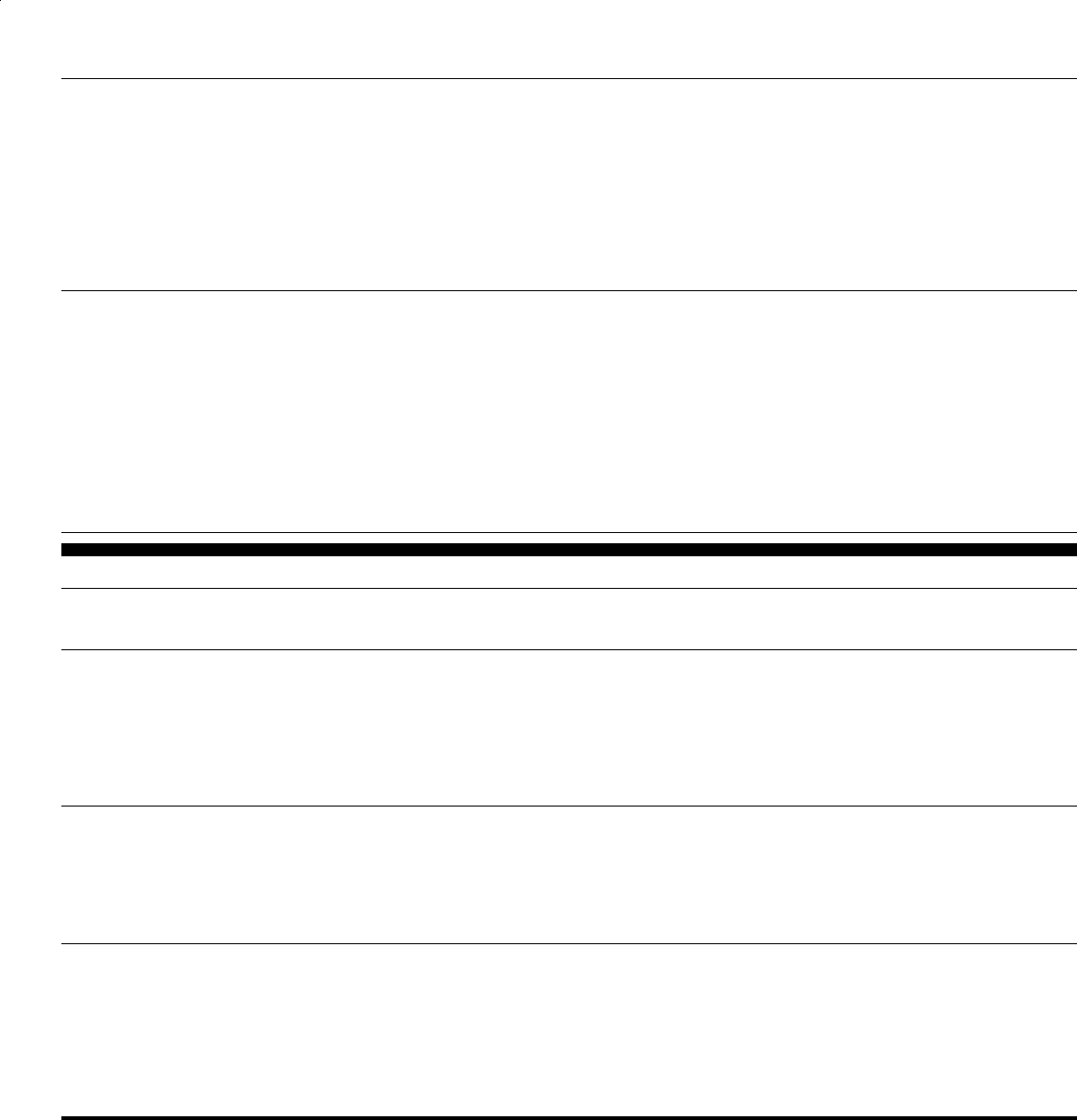
B-283016
The regulatory tests vary among the three categories of
employees—executive, administrative, and professional. Table 1
summarizes the major tests required for each type of exemption. For each
category of employee, we identify the salary levels included in the
regulations and the associated duties test. We refer to the lower salary as
the base salary, and the applicable duties test as the long test. The higher
salary level is referred to as the upset test, and the applicable duties test as
the short test.
Table 1: Summary of Current Regulatory Tests for Executive, Administrative, and Professional FLSA Exemptions
Employee type Paid a salary
Base salary
(triggers long
duties test) Long duties test
Upset salary
(triggers short
duties test) Short duties test
Executive Yes $155 per week Various indicators,
including a primary
duties test and a
requirement that no
more than 20 percent of
work (or 40 percent if in
retail or service) involve
nonmanagerial work
$250 per week (1) Must supervise two or
more employees, and (2)
primary duty must be
management
Administrative Yes; also may
be paid on a
fee basis
$155 per week Primary duties test
including the
percentage limitations
on nonexempt work,
plus other indicators of
administrative
responsibilities
$250 per week (1) Primary duty must involve
office or nonmanual (or staff)
work directly related to
management, and (2) work
must require discretion and
independent judgment
Professional Yes; also may
be paid on a
fee basis
$170 per week Primary duties test
including the
percentage limitations
on nonexempt work,
plus other indicators of
professional
responsibilities
$250 per week Either (1) must have requisite
academic degree and job
must require consistent
exercise of discretion and
independent judgment, or (2)
must involve original and
creative work requiring
invention, imagination, or
talent in recognized field
Source: GAO analysis of DOL regulations.
GAO/HEHS-99-164 FSLA and White-Collar ExemptionsPage 7

B-283016
Number of
White-Collar
Exemptions Increases
With Growth of
Service Sector
We estimate that between 19 and 26 million full-time wage and salary
workers
7
were covered by the white-collar exemptions in 1998.
8,9
This
amounts to 20 to 27 percent of the full-time labor force. Based on the high
estimate of 26 million, our estimate represents an increase of 9 million
workers over our 1983 estimate of 17 million exempt full-time wage and
salary workers (see table 2). For a detailed description of the methods
used to obtain these estimates, see appendix I.
Table 2: Estimates of Full-Time White-Collar Workers Exempt in 1983 and 1998
High estimate Low estimate
Covered by white-collar exemptions
Year
Total full-time wage
and salary workers
(millions)
a
Number of
employees
(millions)
Percentage of
full-time wage and
salary workers
Number of
employees
(millions)
Percentage of
full-time wage and
salary workers
1983 71 17 24% 12 17%
1998 96 26 27% 19 20%
Notes: Includes employees exempt under sec. 13(a)(1) of the FLSA. 29 C.F.R. 541 defines those
employees classified as executive, administrative, professional, or outside sales workers. Outside
sales workers are not included in this analysis. Please see app. I for a discussion of these
estimates.
a
Wage and salary employment numbers are from the CPS Outgoing Rotations Data analysis and
match the Bureau of Labor Statistics (BLS)-published Employment and Earnings annual
averages.
Source: CPS Outgoing Rotations Data for 1983 and 1998.
Much of the growth in exempt workers can be attributed to the growth in
the service sector of the economy. In 1998, the service industries
employed 24 million full-time workers—nearly doubling from 13 million
workers in 1983. All sectors of the labor market saw some growth in the
number of workers between 1983 and 1998;
10
however, no other sector has
7
Full-time wage and salary workers exclude self-employed workers and workers under age 16.
8
For each of 257 job titles, DOL provided us with a range estimate—for example, 10-50 percent—of the
employees in that job category who would probably be exempt. We arrived at our low estimate
(19 million) by using the lower ends of DOL’s individual job category range estimates, and at the high
estimate (26 million) by using the upper ends of those individual estimates.
9
Our work is not an attempt to count the actual number of people classified as exempt by American
employers, but rather to estimate how many full-time workers are covered by the white-collar
exemptions.
10
The number of full-time wage and salary workers grew between 1983 and 1998 as follows: services,
13 to 24 million; retail trade, 8 to 13 million; manufacturing, 18 to 19 million; finance, insurance, and
real estate, 5 to 7 million; other, 14 to 18 million; and public sector, 13 to 16 million.
GAO/HEHS-99-164 FSLA and White-Collar ExemptionsPage 8
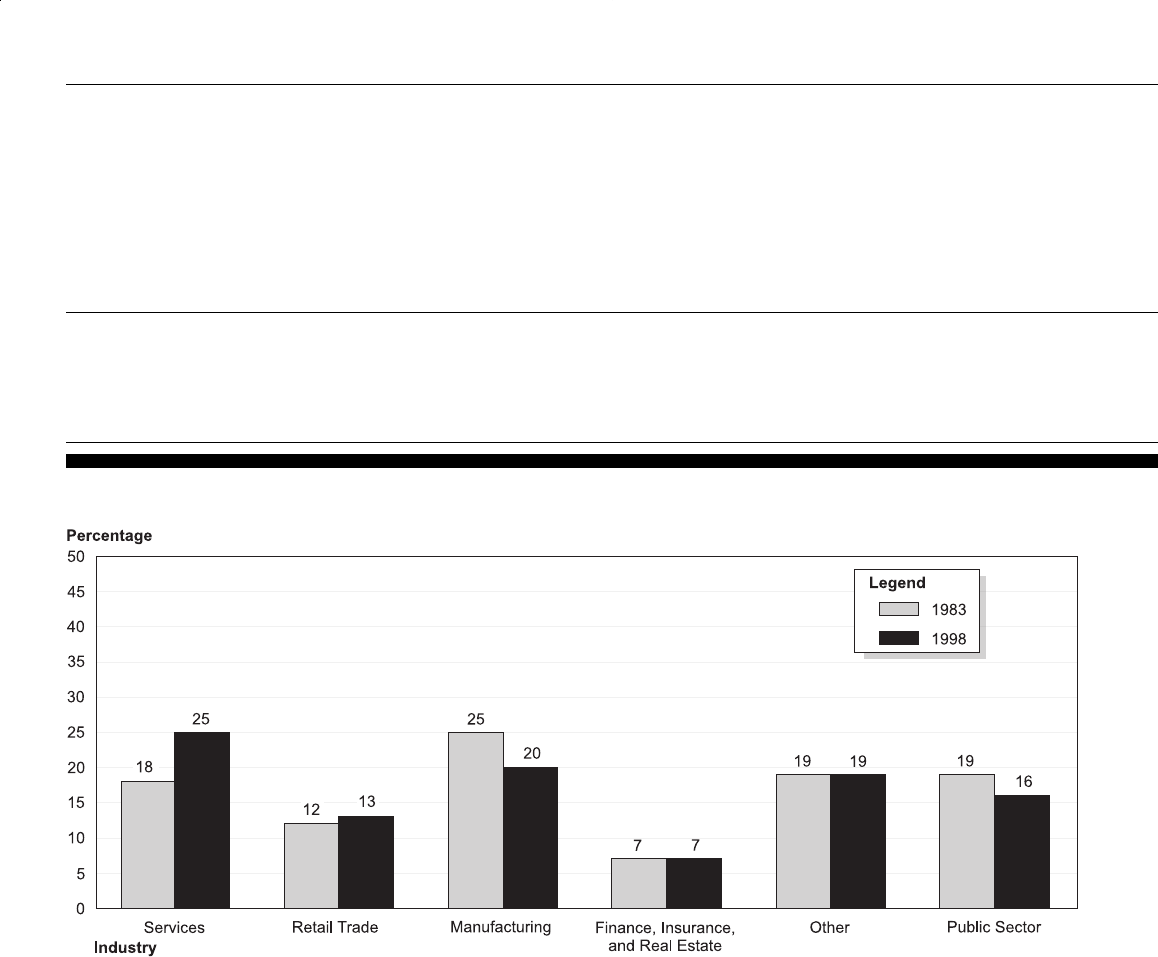
B-283016
grown as rapidly in the last 15 years. As figure 1 shows, in 1998 one-quarter
of all full-time workers held jobs in the service sector, which makes it the
largest employment sector.
Figure 1: Percentage of Full-Time Wage and Salary Workers in 1983 and 1998 by Industry
Notes: The sampling errors for the estimates in this figure do not exceed plus or minus
0.5 percentage points at the 95% significance level.
Service industries included four types of service occupations from the Current Population Survey
(CPS) industry codes: business and repair, personal, entertainment and recreation, and
professional and related services. For definitions of other industries discussed in this report, see
app. I.
Source: CPS Outgoing Rotations Data for 1983 and 1998.
In addition to growing rapidly, the service sector also has a higher
proportion of exempt workers than other sectors and is responsible for
much of the growth in the exempt population. Not only has the service
sector grown by 11 million full-time workers in the last 15 years, but the
number of exempt workers in the service sector has increased by
GAO/HEHS-99-164 FSLA and White-Collar ExemptionsPage 9
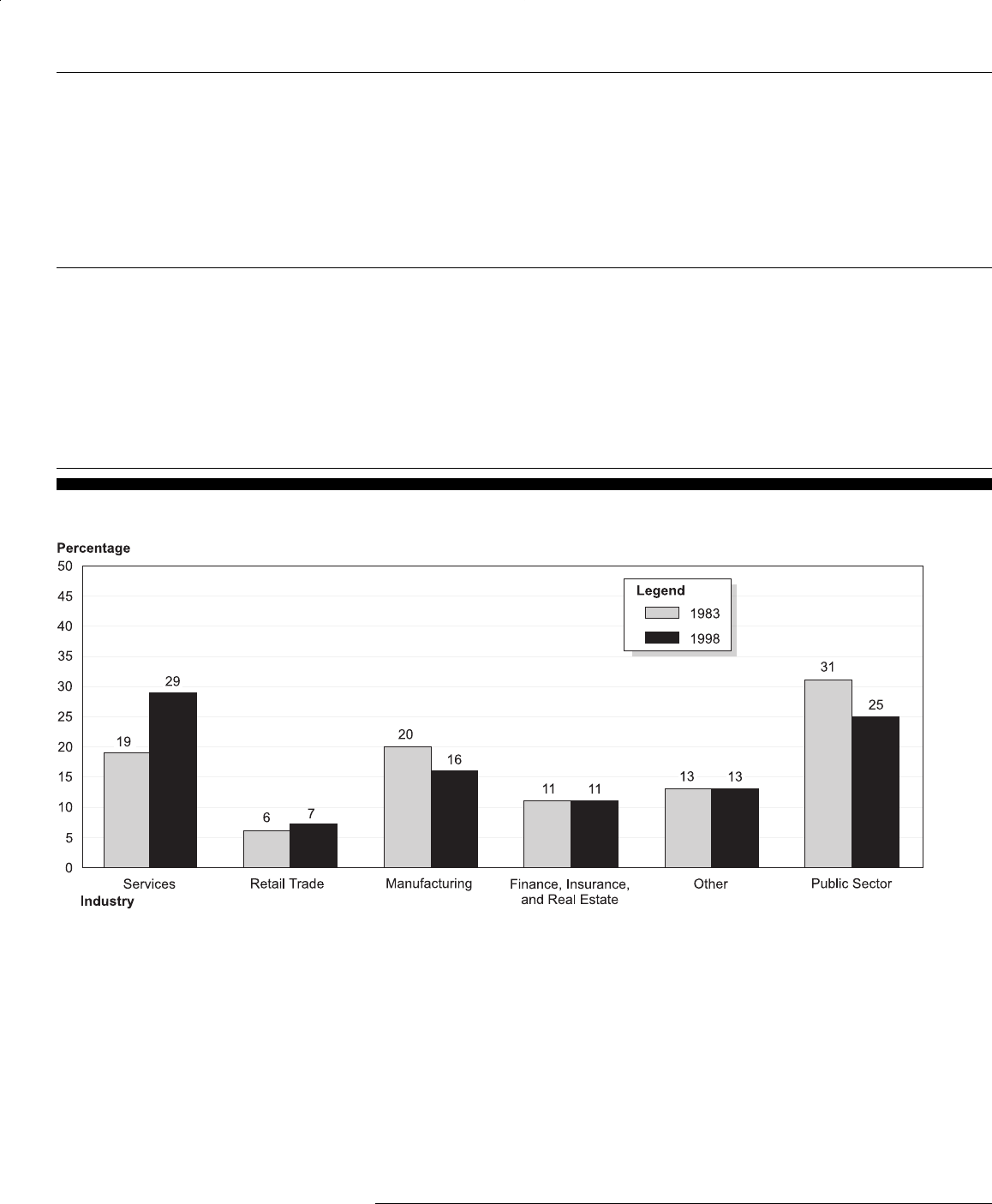
B-283016
3.6 million.
11
Over the last 15 years, the increase in the number of full-time
workers covered by the white-collar exemptions has been about 8 million.
The increase of 3.6 million exempt workers in the service sector over this
same time represents about 46 percent of the overall growth in exempt
workers. As a result of this rapid growth, 29 percent of all exempt workers
worked in the service sector in 1998—up from 19 percent in 1983 (see
figure 2).
Figure 2: Percentage of Full-Time White-Collar Workers Exempt in 1983 and 1998 by Industry
Notes: The percentage estimates represent the average of the high and low estimates. See app. I
for a discussion of these estimates.
Service industries included four types of service occupations from the Current Population Survey
(CPS) industry codes: business and repair, personal, entertainment and recreation, and
professional and related services. For definitions of other industries discussed in this report, see
app. I.
Source: CPS Outgoing Rotations Data for 1983 and 1998.
The demographic composition of the exempt population has significantly
changed in the last 15 years. In 1998, 42 percent of exempt workers were
11
This estimate and those that follow represent the average of the high and low estimates. Please see
app. I for a discussion of these estimates.
GAO/HEHS-99-164 FSLA and White-Collar ExemptionsPage 10
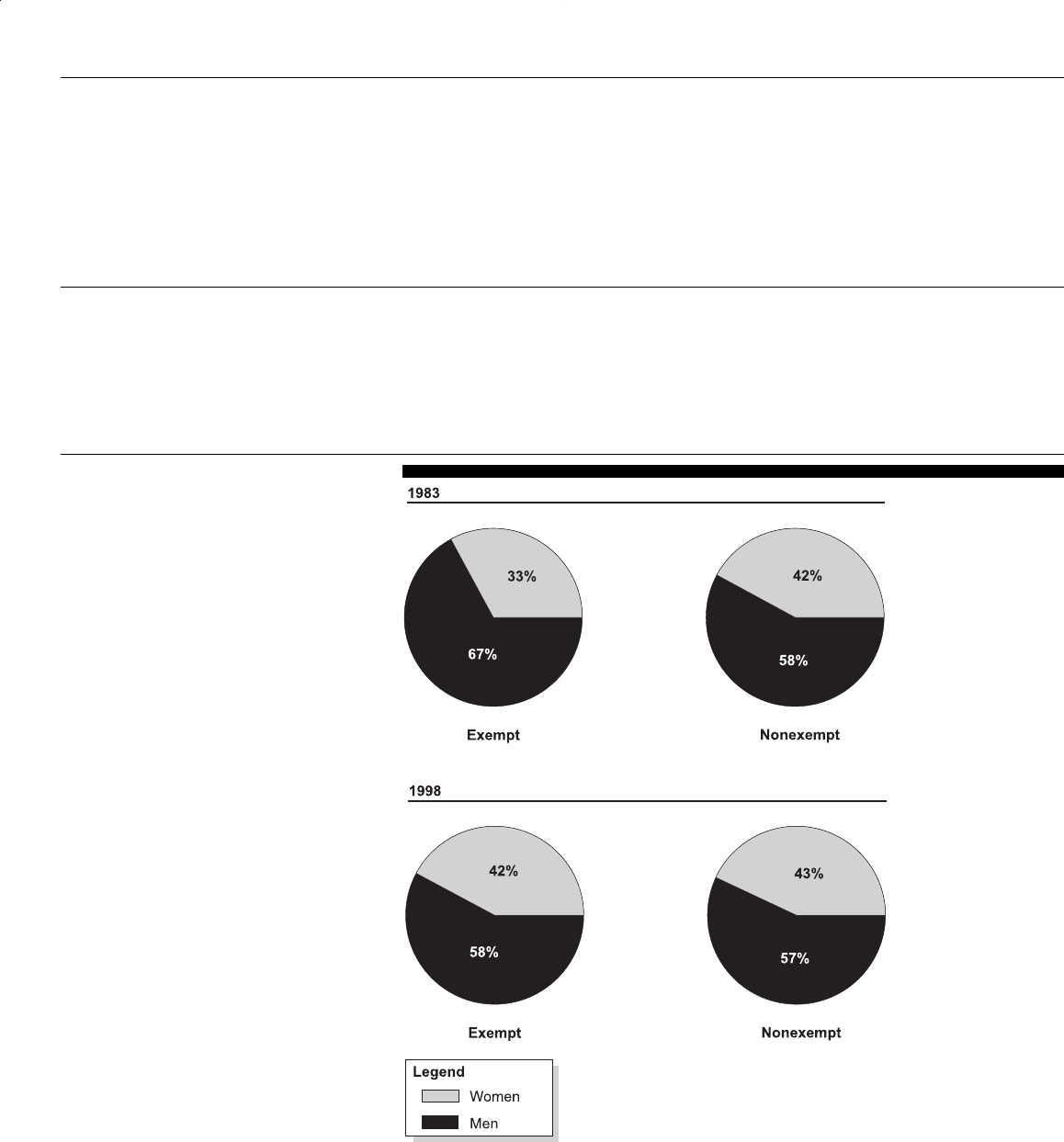
B-283016
women, compared to 33 percent in 1983 (see figure 3). On the other hand,
the gender distribution of nonexempt workers has not changed in the last
15 years. About 40 percent of nonexempt workers were women in both
1983 and in 1998. These data indicate that more women than men entered
full-time white-collar positions over this period.
Figure 3: Percentage of Full-Time
White-Collar Exempt and Nonexempt
Workforce in 1983 and 1998 by Gender
Note: The percentage estimates represent the average of the high and low estimates. See app. I
for a discussion of these estimates.
Source: CPS Outgoing Rotations Data for 1983 and 1998.
GAO/HEHS-99-164 FSLA and White-Collar ExemptionsPage 11
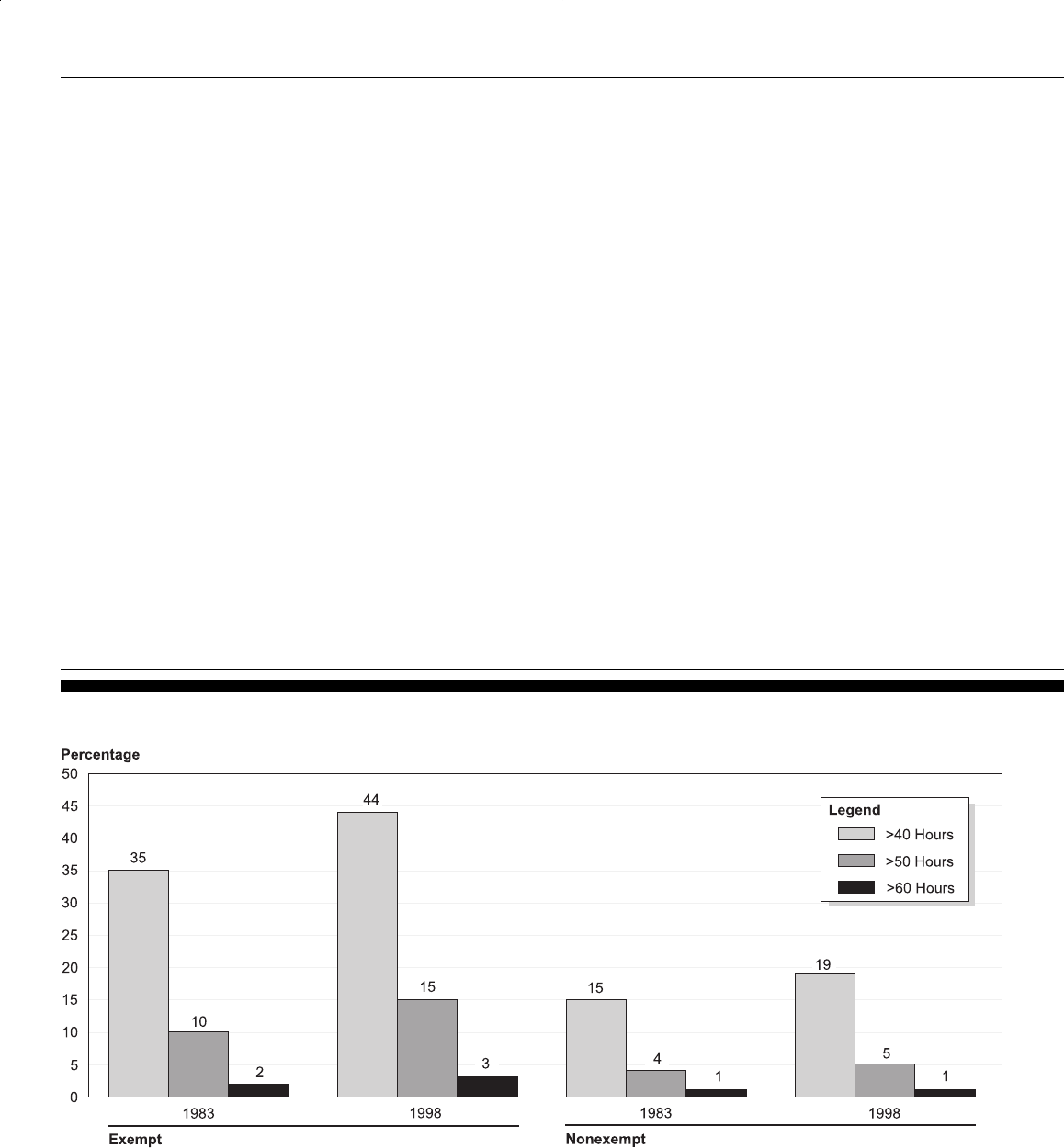
B-283016
Full-time workers covered by the white-collar exemptions are much more
likely to work overtime—that is, more than 40 hours per week—than
nonexempt workers (see figure 4). As figure 4 shows, in 1998, nearly
half—44 percent—of the 19 to 26 million full-time workers covered by the
exemptions said they worked overtime at their primary job. In 1983, about
one-third—35 percent—of full-time exempt workers worked more than 40
hours per week. In fact, exempt workers were more than twice as likely to
work overtime in both 1983 and 1998 as nonexempt workers. In general,
the amount of overtime hours worked by both exempt and nonexempt
workers was greater in 1998 than in 1983. In this regard, in 1998, about
15 percent of exempt workers worked more than 50 hours per week and
3 percent worked more than 60 hours per week at their main job. This
compares to 10 percent working more than 50 hours per week and
2 percent working more than 60 hours in 1983.
Figure 4: Percentage of Full-Time Exempt and Nonexempt White-Collar Workers Who Worked Overtime in 1983 and 1998
Note: The percentage estimates represent the average of the high and low estimates. See app. I
for a discussion of these estimates.
Source: CPS Outgoing Rotations Data for 1983 and 1998.
GAO/HEHS-99-164 FSLA and White-Collar ExemptionsPage 12
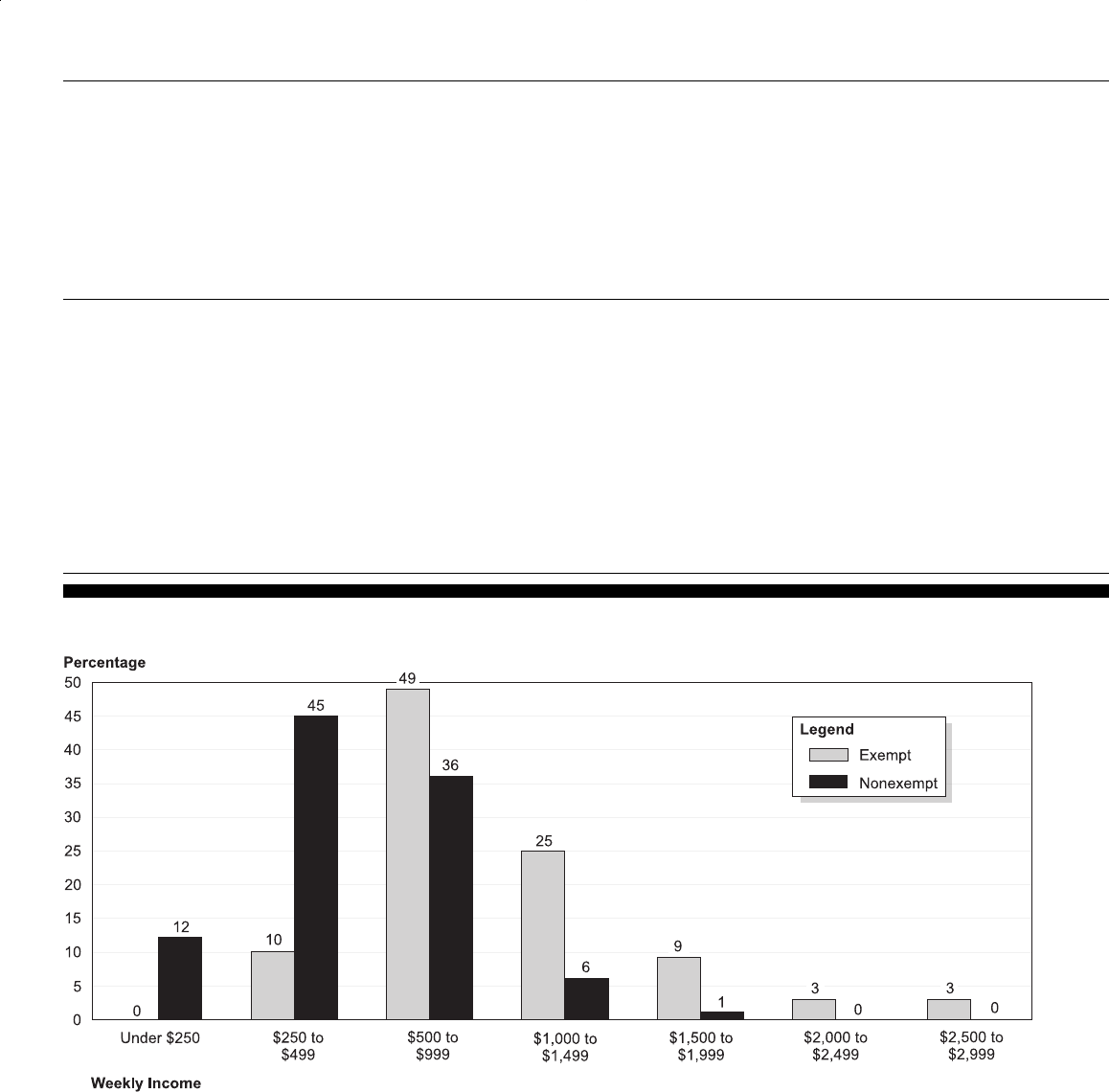
B-283016
As figures 5 and 6 show, exempt workers earned substantially more than
nonexempt workers in 1998. In figure 5, 40 percent of exempt workers
earned $1,000 or more per week, compared to only 7 percent of
nonexempt workers. Conversely, 57 percent of nonexempt workers
earned less than $500 per week, compared to only 10 percent of exempt
workers.
Figure 6 illustrates that there are many fewer exempt workers than
nonexempt workers.
Figure 5: Percentage of Full-Time Exempt and Nonexempt White-Collar Workers in 1998 by Weekly Income
Note: The percentage estimates represent the average of the high and low estimates. See app. I
for a discussion of these estimates. The zero percentages in this table are the result of rounding
and represent a number between 0 and 0.5 percent.
Source: CPS Outgoing Rotations Data for 1998.
GAO/HEHS-99-164 FSLA and White-Collar ExemptionsPage 13

B-283016
Figure 6: Number of Full-Time Exempt and Nonexempt White-Collar Workers in 1998 by Weekly Income (in Millions)
Note: The numerical estimates represent the average of the high and low estimates. See app. I for
a discussion of these estimates. The zeros in this table are the result of rounding to the nearest
million and represent a number between 0 and 500,000 people.
Source: CPS Outgoing Rotations Data for 1998.
In 1998, the average weekly earnings of full-time exempt workers were
nearly twice those of nonexempt workers—$1,018
12
weekly compared to
$526 for nonexempt workers. The difference in earnings between exempt
and nonexempt workers was similar in 1983.
Few Major Changes in
Exemption Laws and
Regulations Since
1954
In the 61 years since the enactment of the FLSA, there have been few major
changes to the statutory and regulatory provisions for the white-collar
exemptions. Between 1938 and 1954,
DOL established its basic set of
regulatory tests—the salary-basis test, the salary-level tests, and the
various duties tests. Although
DOL made a public request for views on
restructuring the regulations in 1985, it has not acted to alter the general
12
The earnings figures reported here are earnings from the respondent’s main job before taxes or other
deductions including earnings from overtime pay, commissions, or tips from that job.
GAO/HEHS-99-164 FSLA and White-Collar ExemptionsPage 14

B-283016
way the regulatory tests work since 1954. Changes after 1954 have
primarily involved adjustments to the salary-test levels and to the tests
applicable to specific types of workers, such as retail workers, state and
local government employees, and computer programmers.
In the 16 years following the enactment of the
FLSA in 1938, DOL established
the regulatory tests used to determine whether an employee should be
classified as an exempt white-collar worker. These tests evolved as
DOL’s
experience with administering the tests grew. For example, the first set of
regulations in 1938 included a single test for executives and
administrators. Two years later, responding to numerous criticisms,
DOL
drafted two separate definitions—one for “executives,” to apply to people
who are bosses, and another for “administrative” employees, to apply to
people who carry out management policies but who do not supervise other
employees.
DOL made its final change to the structure of the basic tests in
1954, when it adjusted the exceptions to the salary-basis requirement.
Since 1954, statutory and regulatory revisions have, in general, either
(1) adjusted the salary levels upward or (2) modified the coverage of the
exemption, extending or reducing coverage for a particular type of
worker. The salary levels were adjusted in 1958, 1963, 1970, and 1975.
DOL
last attempted to increase these levels in 1981; a Presidential order,
however, indefinitely postponed these increases. In 1961, statutory and
regulatory revisions eliminated a separate exemption covering most retail
workers and specifically included these workers under the white-collar
exemptions. Other statutory and regulatory changes expanded coverage of
the exemptions to teachers (1967)
13
and certain higher-wage computer
professionals (1992). A regulatory revision in 1992 limited the effect of the
salary-basis requirement for state and local governments.
All statutory and regulatory revisions on white-collar exemptions are
presented in appendix II. The major changes are summarized in table 3.
13
As pointed out in table 3, public educational institutions were not covered by the FLSA until 1967.
GAO/HEHS-99-164 FSLA and White-Collar ExemptionsPage 15

B-283016
Table 3: Summary of Major Statutory
and Regulatory Revisions to the
White-Collar Exemptions
Year of revision Summary of revision
1938 through 1954 Basic regulatory tests set forth in regulations
1961 Separate retail trade exemption repealed but retail
employees were included, with a limitation, under the
general coverage of the white-collar exemption
1967 FLSA was applied to public educational institutions but
teachers and school administrators were included under
the exemption
1973 The equal pay provision of the FLSA was made
applicable to all those included under the white-collar
exemption
1992 Under certain circumstances, state and local government
workers were excepted from selected aspects of the
salary-basis requirement
Certain computer professionals earning over 6-1/2 times
the minimum wage were exempted from the FLSA, even
though they were paid an hourly wage
Source: GAO analysis of statutory and regulatory provisions.
Employers Believe the
Regulatory Tests Are
Too Complicated and
Outdated for the
Modern Work Place
From our reviews of 166 federal court cases
14
involving litigation on this
subject and 66
DOL compliance cases,
15
as well as our discussions with
employers,
DOL officials, and various legal and economic experts, the
following three issues stood out as being of particular concern to
employers:
• First, the complex requirements of the salary-basis test or the so-called
“no-docking” rule presented possibly the greatest potential liability for
employers and made it difficult to account for employees’ time and
actions.
• Second, the traditional limits of the white-collar exemptions between the
highly paid, very skilled nonexempt technical workers and the exempt
professional and administrative employees have been blurred in the
modern work place.
• Third, the requirement for independent judgment and discretion on the
part of administrative and professional employees was a major area of
contention in
DOL audits involving the white-collar exemptions.
14
We reviewed 5 years of judicial opinions (1994 through 1998) for both federal district court and
federal appellate court cases.
15
We reviewed 66 compliance cases closed in the past 2 years in four DOL field offices.
GAO/HEHS-99-164 FSLA and White-Collar ExemptionsPage 16

B-283016
Employers Cite Perceived
Difficulties of Salary-Basis
Test
The salary-basis test requires that exempt white-collar employees be paid
a set salary each pay period, rather than an hourly wage. The test appears
to rest upon the assumption that employers would pay managerial and
professional employees who are key to their business operations a
guaranteed salary regardless of the number of hours worked. In the
DOL
enforcement program, this test is viewed as an accurate indication of
managerial and professional status. The test, however, effectively limits
the ability of employers to “dock” exempt employees’ pay for such things
as part-day personal absences and disciplinary violations (hence, the
so-called no-docking rule). Employers object to the test because in their
opinion (1) compliance requires exacting adherence to the no-docking
requirements, leaving them vulnerable to private lawsuits by multiple,
well-paid employees; and (2) it limits their ability to hold their exempt
employees accountable for their time and actions.
In general,
DOL regulations specify that employees can be exempt
executives, administrators, and professionals only if they are paid on a
salary basis—that is, employers must pay them a full salary for any week
worked “without regard to the number of days or hours worked.” Although
there are exceptions to this rule,
16
a private employer
17
may not dock an
exempt employee’s pay for absences of less than a full day—for whatever
reason—without violating the salary-basis test. In addition, neither public
nor private employers can dock an exempt employee’s pay for periods of
less than a week to enforce disciplinary rules except for a violation of a
safety rule of major significance. Employers, therefore, must pay exempt
employees a full weekly salary even though the employees may, for
example, take time off during the day for an extended lunch or a visit to
the dentist. Further, employers cannot suspend exempt employees without
pay for less than 1 week for such things as tardiness or unexplained
absenteeism.
In our interviews, employers and their representatives discussed the
complex requirements of the salary-basis test, and their concerns that if
they should not comply with the requirements, they may face lawsuits
brought by multiple (and possibly highly paid) employees for back wages
and other damages. Under the
FLSA, employees may sue their employer
either individually or collectively for up to 2, and in some cases 3, years of
16
Exceptions to the rule include deductions of a day or more for personal reasons other than sickness
and accident, deductions of a day or more for sickness if in accordance with company policy, and
deductions for violation of safety rules of major significance.
17
A 1992 amendment to the regulations allowed state and local governments to dock employees’ pay
for part-day absences under certain circumstances.
GAO/HEHS-99-164 FSLA and White-Collar ExemptionsPage 17

B-283016
back wages plus other damages. In our review of federal court cases, we
found that the salary-basis test has been the central focus of cases brought
by employees against their employers. Our review of 166 federal cases
involving the white-collar exemptions litigated in the past 5 years showed
that about 50 percent involved employee suits alleging that employers
improperly claimed exemptions for employees who did not meet the
salary-basis test.
For the most part, the salary-basis cases involved groups of supervisory or
professional employees collectively suing their employers. However, the
large majority of cases were initiated by groups of managerial public
employees (such as police and fire chiefs, senior corrections officers)
against state and local governments,
18
most often because the government
could suspend or had suspended the pay of exempt employees as a
penalty for disciplinary infractions. Overall, over 70 percent of the
salary-basis cases were collective actions, and about 70 percent were
lawsuits against state and local governments.
A 1997 Supreme Court case, Auer v. Robbins
, reduced employers’ potential
for liability from these lawsuits.
19
In this case, a large group of senior
police officers sued a city government because its disciplinary suspensions
appeared to apply to exempt officers even though the city had only
suspended one police sergeant. The court ruled in favor of the city, and
effectively limited employers’ liability for improper pay docking to cases
where there is an “actual practice” or a “significant likelihood” of such
action. Prior to this decision, some federal cases had ruled that an
employer did not meet the salary-basis test if there were only a possibility
that the employer might improperly dock an exempt employee’s pay. The
result of this ruling is that fewer cases have resulted in liability for
employers—our review of 42 federal cases following Auer
showed that 30
were decided in favor of the employers. However, the full effect of the
Auer
ruling has yet to be determined.
Our discussions with employers and review of other federal cases showed
a variety of circumstances in which employers were uncertain about the
18
In a recent decision, Alden v. Maine, 119 S.Ct. 2240 (1990), the Supreme Court ruled that state
employees cannot sue a state in state courts for overtime wages under the FLSA if the state has not
waived its sovereign immunity. A previous Supreme Court decision, Seminole Tribe of Fla. v. Florida,
517 U.S. 44 (1996), precluded such suits in federal courts.
19
519 U.S. 452.
GAO/HEHS-99-164 FSLA and White-Collar ExemptionsPage 18

B-283016
limits of the test. Some examples
20
of questions concerning these
circumstances include the following:
• What constitutes an “actual practice” of pay docking? When does one
instance connote an actual practice?
• When can employers correct instances of improper pay docking and not
incur liability?
• What happens when an employee has no accrued leave? Can an employer
deduct from accrued compensatory time?
• The Family and Medical Leave Act requires employers to give employees
unpaid leave for serious medical conditions; if such leave is taken in
partial-day increments, does it violate the salary-basis test?
• Under what circumstances can employers pay hourly overtime to exempt
workers and maintain time sheets or set work hours?
• Can an employee be disciplined for failure to complete a work shift?
• An employer cannot suspend an exempt employee for less than a week; if
the suspension is for more than a week, must the employer suspend the
employee only in weekly increments?
In Auer
, the Supreme Court expressly deferred to the Secretary of Labor
as the expert on regulatory interpretation of the salary-basis test.
According to legal experts we talked to, clear guidance to employers from
DOL on the technical requirements of the test may resolve some
uncertainties. However, they indicated that it can be difficult for the public
to locate published legal advice from
DOL. As one solution, they suggested
that
DOL make its “opinion letters”—legal guidance it routinely provides to
individual employers—more widely available to the general public, for
example, by putting them on the Internet.
However, even where the requirements of the salary-basis test were
relatively clear, employers argued that the effects on their operations
created anomalies. In the retail industry, for example, employers cannot
dock an exempt employee’s pay to recoup losses from cash shortages or
employee theft. If they do so, the employee is considered nonexempt and
entitled to overtime wages. Employers complained that this rule unduly
limits their ability to recover losses where responsibility clearly rests with
one employee, such as when an employee delivering cash receipts to a
bank loses the cash or an employee uses a corporate credit card for
personal items.
20
In commenting on this report, DOL stated that it believes some of the legal issues raised by
employers have been authoritatively addressed in either the case law or the law itself. Our review of
the case law indicates that legal conclusions on issues related to the salary-basis test can vary
depending upon the factual circumstances of individual cases.
GAO/HEHS-99-164 FSLA and White-Collar ExemptionsPage 19

B-283016
Officials from three large local governments
21
told us that the salary-basis
test made it difficult to penalize employees with systematic disciplinary
steps. All three local governments are heavily unionized and to satisfy the
union contracts they must use “progressive discipline.” This means that
before harsh disciplinary actions—such as long-term suspensions or
termination—can be used to discipline an employee, less severe
disciplinary measures—such as part-day suspensions without pay—must
be taken to alert the employee to performance problems. However, the
officials contend that the salary-basis test prevented them from taking
such lesser measures.
DOL officials told us that they believe that payment on a salary basis
remains one of the best indicators of managerial and professional status.
This belief is longstanding. As a 1940
DOL report explained:
. . . The term “executive” implies a certain prestige, status, and importance. Employees who
qualify under the definition are denied the protection of the act. It must be assumed that
they enjoy compensatory privileges and this presumption will clearly fail if they are not
paid a salary substantially higher than the wages guaranteed as a mere minimum under
section 6 of the act. In no other way can there be assurance that section 13 (a) (1) will not
invite evasion of section 6 and section 7 for large numbers of workers to whom the
wage-and-hour provisions should apply. Indeed, if an employer states that a particular
employee is of sufficient importance to his firm to be classified as an “executive” employee
and thereby exempt from the protection of the act, the best single test of the employer’s
good faith in attributing importance to the employee’s services is the amount he pays for
them. The reasonableness and soundness of this conclusion is sustained by the record.
A 1949 DOL report rejected proposals to eliminate the salary-basis test,
commenting that “[C]ompensation on a salary basis appears to have been
almost universally recognized as the only method of payment consistent
with the status of the ‘bona fide’ executive . . . [and] is one of the
recognized attributes of administrative and professional employment.”
These principles were again reaffirmed in the report and
recommendations of a 1958 hearing report on proposed revisions to the
regulations.
Compliance investigators in
DOL’s Wage and Hour Division said that the
salary-basis test is a key enforcement test. Investigators told us that the
21
Because it is clear that local governments (and other employers) violate the salary-basis test when
they discipline their management officials by suspensions without pay, all three local governments we
talked to have made large groups of their employees nonexempt rather than give up their disciplinary
systems. One now pays its senior police officials overtime, another has limited its exempt workers to
those paid over $73,000 per year, and the third has made nearly all union workers nonexempt
(90 percent of its employees are unionized).
GAO/HEHS-99-164 FSLA and White-Collar ExemptionsPage 20

B-283016
first review they routinely undertake involves determining whether the
exempt employees are paid on a salary basis. However, as one investigator
explained to us, testing for compliance can be difficult because most often
exempt employees have worked in excess of 40 hours and have been paid
for at least 40 hours, making it hard to prove that employers have made
improper deductions to the salaries of exempt workers. Although we
found that the salary-basis test was not the central issue in most
compliance cases we reviewed, it was critical to some cases. In one case,
for example, a gas service station owner paid managers and assistant
managers a salary of $400 per week and required them to work 60 hours
per week. Although the owner claimed the employees to be exempt
executives, the investigator successfully challenged their executive status
because the owner reduced their pay if they worked less than 60 hours per
week.
Employers Say Some
Production Workers Are
Equivalent to White-Collar
Employees
Nonsupervisory employees may be exempt from the FLSA if they can be
classified as either administrative or professional employees. However, the
administrative exemption is limited to those employees who perform
nonmanual (or nonproduction) work “directly related to the management
policies or general business operations” using independent judgment and
discretion, and the professional exemption is generally limited to
occupations requiring advanced academic degrees.
22
Thus, as interpreted
for the past 60 years, these exemptions do not apply to many technical
workers—nonsupervisory line workers who work to produce the
employer’s goods and who do not have the requisite academic degree for a
recognized profession in which they are employed.
In our discussions with employers and state and local government
representatives, both groups argued that the traditional limits of the
white-collar exemptions are outdated in the modern work place. They
believed that certain highly skilled, well-paid line workers should be
treated as exempt workers because they have the knowledge equivalent to
an exempt professional. Officials from manufacturing employers pointed
to new technology used in factory work places, which they said required
advanced technical skills but required far less traditional “manual” labor.
Moreover, they told us that while these workers may have to follow
precise written guidelines to perform their work, prescribed procedures
were key to modern quality control. State and local representatives
pointed to job classifications within their organizations which involved
22
There are, however, exceptions for certain specific occupations such as computer programming,
based on a 1990 congressional enactment, and work of an artistic nature.
GAO/HEHS-99-164 FSLA and White-Collar ExemptionsPage 21

B-283016
line work but which required the knowledge and experience of a civil
service professional.
To illustrate the point, one company official described the job of
technicians who maintain unmanned factories around the country. In her
company, one technician, relying upon standardized instruments, monitors
each automated factory. The official compared the nonexempt line jobs of
these well-paid (about $70,000 per year) technicians with those of her
company’s engineers. Both groups held similar jobs and earned
comparable pay, but because the engineers had professional degrees and
the technicians did not, only the engineers could be classified as exempt
professional employees.
In general, employers pointed to the differences between exempt and
nonexempt employee status as creating difficulties in managing the
workforce, particularly in what they referred to as crossover positions like
the technicians described above. According to the employers, nonexempt
employees have less flexibility in work shifts—any work over 40 hours
must be paid at overtime rates, even if the employee is planning on
working less than 40 hours in the next work-week. Further, employers
claim that workers look on exempt status as prestigious, allowing greater
possibility of management promotion. In addition, employers also believed
that adherence to strict written guidelines—one major distinction between
exempt and nonexempt workers—is necessary in a modern, efficient work
place.
In recent years, the distinctions between production and nonproduction
workers, and between professional and technical production workers,
have been increasingly blurred. The federal court cases and
DOL
compliance cases we reviewed provided illustrations of recent distinctions
made between exempt and nonexempt nonsupervisory workers. These
cases included the following:
• A large publishing firm employed about 50 production editors, each of
whom managed the final publication processing of the company’s books.
One of these production editors sued the company, claiming that she was
improperly classified as an exempt employee. A federal appellate court
ruled that, although her job involved production work, she was an exempt
employee. It found that her work was a major assignment of the company
and, therefore, that it was directly related to the management policies or
business operations of the company.
23
23
Shaw v. Prentice Hall Computer Publishing, Inc., 151 F.3d 640 (7
th
Cir. 1998).
GAO/HEHS-99-164 FSLA and White-Collar ExemptionsPage 22

B-283016
• An insurance company employed automobile damage appraisers to
determine the amount to be paid on auto insurance claims. A federal
district court found the appraisers to be nonexempt production workers
because they did not do work related to the management policies or
business operations of the firm. Rather than administratively running the
business, they carried out the daily affairs of the company.
24
• A title insurance company used escrow closers to conduct final property
settlements. A federal district court held that these were nonexempt
employees who were carrying out the day-to-day operations of the
company
25
and that it was irrelevant that they were not part of the
company’s production department.
• One southern state’s Department of Agriculture employed dairy inspectors
and food safety inspectors. The dairy inspectors had academic training
and experience in the specific area of dairy or animal sciences, while the
food safety inspectors had more generalized academic training in
biological sciences.
DOL compliance review determined that only the dairy
inspectors met the educational requirement of the professional exemption.
The Requirement for
Independent Judgment and
Discretion Is Difficult to
Apply
To be classified as either an exempt administrative or professional
employee, each employee must exercise independent judgment and
discretion in carrying out his or her job duties. In general, the requirement
for exercising independent judgment and discretion means that employees
have the freedom to make choices about matters of significance to their
employers, without immediate supervision or detailed guidelines. Factors
which are taken into account include (1) the amount of supervision,
(2) the amount of written guidelines, and (3) whether the work involves
routine matters. For example, a newly hired accountant may be given
work that is closely supervised, involving rote work with set procedures.
In that case, the accountant would be nonexempt, even though he or she
may have full professional certification.
Our discussions with employers and
DOL investigators indicated that this
aspect of the regulations is particularly difficult to apply for both the
employers and the investigators. Employers complained that the standards
for the independent judgment requirement were confusing and applied in
an inconsistent manner by
DOL. Thus, employers were unsure of how to
properly classify administrative personnel. According to
DOL investigators,
determinations about independent judgment and discretion can be the
most difficult part of a compliance review. To assess this requirement, an
24
Reich v. American International Adjustment Co., Inc., 902 F. Supp. 321 (D. Conn. 1994).
25
Reich v. Chicago Title Insurance Co., 853 F. Supp. 1325 (D. Kan. 1994).
GAO/HEHS-99-164 FSLA and White-Collar ExemptionsPage 23

B-283016
investigator must review both the general duties of the position and the
specific duties of the employee. Further, the determination may hinge
upon how an individual employee views his or her own duties. For
instance, one administrative assistant may look at his job as answering
telephone calls and following orders, while another person in the same
position might describe the job as involving the independence to establish
office procedures and respond to incoming client inquiries.
The compliance cases we reviewed included a number of instances where
the standard for independent judgment and discretion was key to
determining the employee’s status. Situations where this question arose
included the following:
• A trucking company employed dispatchers to organize and schedule truck
routes. Two of the dispatchers negotiated with other companies to obtain
contracts for truck loads, as well as scheduling truck routes. The
DOL
compliance investigator allowed the administrative exemption for the two
senior dispatchers, but not for the other dispatchers.
• A firm provided library services to professional firms. Firm officials
claimed that certain librarians were exempt as either administrative or
professional employees. The
DOL investigator disagreed, finding the
librarians were nonexempt because their work—filing and updating
loose-leaf volumes—was “routine and not dependent on a professional
degree.”
• An architectural firm hired professional architects and engineers. The firm
classified its employees according to experience, but considered them all
exempt. The
DOL investigator found that architects and engineers at the
entry level were nonexempt, because they did not exercise discretion and
independent judgment in their jobs.
In our review, we noted certain cases in which an employer conducted its
own self-audit and used this to negotiate a final settlement with
DOL. One
large accounting firm agreed to conduct a self-audit of all of its entry-level
tax reporting accountants, and
DOL agreed to not question the application
of the professional exemptions to second- and third-year accountants. In
another example,
DOL investigators found certain job titles at a commercial
bank that appeared to involve nonexempt work. To settle the compliance
questions, the bank hired a law firm to conduct an audit of individual
employee classifications. The lawyers examined the bank’s
FLSA
classifications and recommended that changes be made. With the approval
of
DOL, the bank accepted the reclassifications suggested by the audit and
agreed to pay the necessary back wages.
GAO/HEHS-99-164 FSLA and White-Collar ExemptionsPage 24

B-283016
Employees Say That
Inflation and
Oversimplification
Have Undermined
Exemption Limits
Employee representatives and other experts were particularly concerned
that the use of the exemptions be limited, maintaining the 40-hour
work-week standard for as many employees as possible. To do this, they
were of the opinion that the regulatory tests should provide the type of
protection originally intended. In this regard, the following two issues
seemed particularly important to employees:
• The salary-test levels that underpin the regulatory framework have been
unchanged since 1975. Because of inflation, the current salary-test levels
are now near the minimum-wage level, rendering the application of certain
regulatory tests to the current workforce virtually meaningless.
• The duties test that determines who can be classified as an exempt
executive has been increasingly simplified by judicial opinions. When
combined with the low salary-test levels, employees believe that few
protections remain for lower-income supervisors.
Inflation Has Effectively
Eliminated Important
Aspects of the Regulatory
Tests
In determining whether an employee is exempt from the FLSA as an
executive, administrator, or professional, the first consideration is the
employee’s salary. Since 1949, employees have been divided into three
groups according to their weekly earnings. As described earlier in table 2,
the standards vary depending on whether an employee is to be classified
as an executive, administrator, or professional. For the executive
exemption, the three groups currently are as follows:
• Employees earning less than $155 per week are automatically nonexempt
(or subject to the
FLSA requirements).
• Employees making at least $155 but less than $250 per week are
nonexempt unless their duties meet the rigorous standards of the so-called
long duties test. The long duties test for executives requires that
employees’ duties include such things as the authority to hire or fire other
employees and the ability to exercise discretion; most significantly,
though, it sets percentage limitations on the amount of nonmanagerial
work an exempt employee can perform in a work-week. Specifically,
employees qualify as exempt employees only if no more than 20 percent
(or less than 40 percent for retail and service employees) of their jobs
involve nonmanagerial or nonprofessional work.
• Employees earning at least $250 per week are exempt as long as their
duties meet the less strict standards of the so-called short duties test, an
abbreviated version of the long duties test. The short duties test does not
specify percentage limitations on the amount of nonmanagerial work an
exempt employee can perform. For executives, the test is limited to
GAO/HEHS-99-164 FSLA and White-Collar ExemptionsPage 25

B-283016
requiring that employees supervise two or more workers and that their
primary duty is managerial.
The practical differences between the long and short duties tests are
significant. To illustrate, consider a cook who supervises a crew of other
workers. If the cook’s salary was $200 per week, and he was thus subject
to the long duties test, he would be nonexempt (and entitled to overtime
wages) if he spent more than 40 percent of his time on nonmanagerial
tasks—work such as cooking food or cleaning the kitchen. If, however, the
cook’s salary was $250 per week, the cook would be an exempt executive
as long as his primary duty was management and included the customary
and regular direction of at least two other employees, even though he may
spend a lot of time cooking food or cleaning the kitchen.
The salary levels used to determine into which of the three salary
categories an employee falls have not been changed since 1975. During
that time period, salaries in the nation have risen considerably. As a result,
the salary levels used by
DOL for this purpose, which in 1975 were
considered fairly high, are now below the level of the federal minimum
wage in the instances of the base salary levels. Even the higher level, $250
per week, is equivalent to an hourly wage that is only $1.10 per hour higher
than the current minimum federal hourly wage of $5.15 for a 40-hour
work-week. For the salary levels used in this determination to represent
the same level of purchasing power now as they did in 1975, they would
need to be considerably higher than their current levels. For example, the
highest of levels, $250 per week, would have to be $757 per week, for an
annual salary of about $39,400. In figure 7, we examine the highest salary
level over the 49-year period between 1949 and 1998, and we compare the
actual level included in the regulations with the level necessary to keep
pace with inflation.
GAO/HEHS-99-164 FSLA and White-Collar ExemptionsPage 26

B-283016
Figure 7: Actual and Inflation-Adjusted Highest Salary Test, or Upset Test, for Weekly Income, 1949-1998
Note: Upset test numbers are adjusted for inflation using the Consumer Price Index for all Urban
Consumers (CPI-U), with 1975 as the base year.
Source: Data for the actual upset test are from 29 C.F.R. chap. V, part 541; inflation-adjusted
upset test calculated by GAO.
To see the effect of inflation on the application of the regulatory tests,
consider again the example of the supervisory cook. Today, the cook
would be automatically nonexempt only if his salary was less than $8,060
per year—the equivalent of $3.88 per hour, $1.27 less than the current
federal minimum wage. The strict long duties test would apply only if he
made less than $13,000 (equivalent to an hourly rate not much higher than
GAO/HEHS-99-164 FSLA and White-Collar ExemptionsPage 27

B-283016
the minimum wage for a 40-hour work-week). And, as long as he made
$13,000, he would be presumed to be an executive if his primary duty was
management—for example, if he can hire and fire workers.
However, if the cook’s salary was adjusted to include the inflation
occurring between 1975 and 1998, the application of the regulatory tests
would be very different. Using salary figures adjusted for inflation, the
cook would be automatically nonexempt as long as he earned less than
$24,400. If he earned between about $24,400 and $39,400, he would be
exempt only if his work met the long duties test. And, if he earned more
than $39,400, he would be an exempt executive if his primary duty were
management.
Because of inflation, the percentage of full-time workers who potentially
fell into each of the three salary level categories was far different in 1975
than in 1998
26
—specifically,
• In 1975, about 30 percent of the full-time workforce would have been
automatically nonexempt workers; in 1998, only 1 percent of the full-time
workforce were automatically nonexempt.
27
• In 1975, about 30 percent of the full-time workforce would have been
nonexempt unless they met the percentage limitation on performing
nonexempt work; in 1998, the long duties test would apply to only
8 percent of the full-time workforce.
• In 1975, about 40 percent of the full-time workers could have qualified as
exempt workers with the application of the short duties test; in 1998,
91 percent of the workers were under the short duties test.
Employees Say That Duties
Test Offers Little
Protection for
Lower-Income Supervisors
During the past 20 years, it has become increasingly easy to classify a
supervisory employee as an exempt executive. If an employee makes over
$250 per week ($13,000 per year), the employee may be an exempt
executive if he or she meets two criteria. First, the employee must
customarily and regularly direct the work of two or more employees; and
second, the employee’s primary duty must involve management. Unlike
the administrative and professional exemptions, there is no express
26
The data we used for these estimates include full-time wage workers as well as full-time salaried
workers age 16 years and over. The data were provided by BLS and are unpublished tabulations from
the CPS. The data for 1998 are annual averages while the data for 1975 are for the month of May, when
annual averages were not available. Self-employed workers are excluded.
27
These percentages are approximate; the CPS data provide the percentage of workers who earn under
$150 per week, rather than under $155 per week, the base salary for exempt executive and
administrative employees.
GAO/HEHS-99-164 FSLA and White-Collar ExemptionsPage 28

B-283016
requirement for independent judgment and discretion. However, the
regulations specify that, “as a rule of thumb,” an employee who spends
more than 50 percent of his or her time on management tasks would have
management as a primary duty.
Two federal court decisions in 1982 clarified the test for determining
whether an employee earning over $250 per week has management as a
primary duty. The cases, involving litigation between
DOL and the Burger
King Corporation,
28
applied the executive exemption to assistant managers
at the fast-food restaurants. First, one decision held that the duties of
Burger King assistant managers were primarily managerial, even though
the company provided them detailed instructions on how they were to
perform their work. Second, both courts found that the 50-percent “rule of
thumb” limitation on nonmanagerial work was only one factor to consider
when determining employees’ primary duty, and that their managerial
duties could be carried out at the same time they were performing manual
work. Thus, assistant managers could be exempt executives even if they
spent most of the day cooking hamburgers—as long as they were in charge
of the restaurants during their shifts.
While employers appreciate the simplicity and the clarity of the executive
duties test, union representatives complained that the judicial rulings
following the Burger King
decisions have oversimplified the executive test.
Under the regulations, as currently interpreted, almost any employee who
is assigned to supervise two or more employees in a particular
“department” of the company can be classified as an exempt employee.
According to the union officials, employers have adjusted their work
places to include many new levels of supervision in order to create exempt
executive positions. Thus, where a grocery store originally had one or two
store managers, it now has many different departments—the meat
department, the produce department, and others—headed by exempt
executives.
Federal case law in the 5-year period from 1994 through 1998 included
hardly any instances in which a court overturned an employer’s
classification of a lower-income supervisor as an exempt executive. In the
32 cases we identified as relating to the executive exemption duties test,
about one-third (12 cases) involved employees whose salaries were $500
per week (or $26,000 per year) or less. Of these 12 cases, only 1 resulted in
28
Donovan v. Burger King Corp., 672 F.2d 221 (1
st
Cir. 1982), and Donovan v. Burger King Corp., 675
F.2d 516 (2d Cir. 1982).
GAO/HEHS-99-164 FSLA and White-Collar ExemptionsPage 29

B-283016
a favorable ruling for the employee. These cases included a wide range of
employees, such as:
• an aquatics director of a community swimming pool paid $376 per week,
• a produce department manager of a grocery store paid $450 per week,
• a dietary manager of a nursing home paid $341 per week, and
• a loss-prevention manager of a department store paid $423 per week.
All of these employees claimed that their jobs consisted primarily of
nonmanagerial work—for example, life guarding, stocking shelves, and
cooking. Despite evidence of large proportions of nonmanagerial work,
the courts found all but one employee to be exempt executives.
Discussions with
DOL investigators and attorneys suggested that the Burger
King decisions and the low salary-test levels have had a major effect on
their investigation of cases involving exempt executives. Since the
decisions, their policy manual has been revised to require that
investigators consider percentage limitations as only one factor when
assessing the employee’s primary duty. One attorney noted that in recent
years little litigation had been initiated by
DOL over the executive status of
supervisory employees. He indicated that, although there may be
situations in which the exempt executive classification of an employee
supervising two or more workers could be challenged, those situations are
very limited.
Conflicting Interests
of Employers and
Employees Make
Resolution of
Concerns Difficult
Legal and economic experts have proposed various ways to deal with the
concerns raised by employers and employees, ranging from tinkering with
particular provisions of the regulations to a major overhaul of the
FLSA.
However, proposals to change the present law or regulations all affect the
regulatory balance between the desires of employers and those of
employees, and there are competing interests that must be carefully
weighed before any changes can be made. For a number of years,
DOL has
been reluctant to alter the existing tests in view of these competing
interests. To illustrate some of these considerations, we discuss four
proposals that have been made by experts to revise the current
regulations, and summarize the general views of employers and employees
on each.
Eliminate the Salary-Basis
Test
From the employer’s point of view, the salary-basis test presents complex
regulatory requirements—for example, the limitations on the use of pay
GAO/HEHS-99-164 FSLA and White-Collar ExemptionsPage 30

B-283016
suspensions to sanction employees’ actions—that have nothing to do with
managerial or professional status but that can be the source of potential
legal liability for unwary employers. However, if the test were eliminated,
the exemption could be applied to both hourly-wage and salaried workers
and only the other two tests—the salary levels and the duties test—would
remain as indicators of managerial and professional status.
DOL contends
that salary remains the general method of compensation for key
managerial and professional employees. From the standpoint of
employees, the salary-basis test is a key enforcement tool to protect
workers from employers who do not comply with the law because it is an
objective measure of managerial and professional status. For employees, it
is particularly important today because the salary-test levels are so low,
and without the salary-basis test,
DOL would be left only with the
difficult-to-apply duties test as the single test of employer compliance.
In commenting on this report,
DOL further explained the rationale for the
salary tests. According to
DOL, the salary tests have been an integral part of
the definitions for the exemptions since 1940. It believes that the statutory
terms “executive, administrative, or professional” imply a certain prestige,
status, and importance, and an employee’s salary serves as one indicator
of his or her status in management or the recognized professions. It is an
index that distinguishes the bona fide executive from the working squad
leader, or distinguishes the clerk or technician from one who performs
true administrative or professional duties.
DOL said that salary remains a
good indicator of the degree of importance attached to a particular
employee’s job, which provides a practical guide, particularly in borderline
cases, for distinguishing bona fide executive, administrative, and
professional employees from those who were not intended by the
Congress to come within the categories of this exemption. In its years of
experience in administering the regulations,
DOL said it has found no
satisfactory substitute for the salary test. The arguments that the salary
test is not needed or that it does not help draw the proper line between
exempt and nonexempt employees have been offered before, including as
part of the hearings and deliberations over amending the regulations in
1940, 1949, and 1958. As then, the
DOL sees no new or more valid reasons
that have been offered for eliminating the salary test from the regulations
than were considered as part of the previous hearings on this question.
Raise the Salary-Test
Levels
If the salary-test levels were raised, the regulatory structure could
incorporate the effects of inflation and function as originally envisioned.
With a higher salary test, both the long and short duties tests would be
GAO/HEHS-99-164 FSLA and White-Collar ExemptionsPage 31

B-283016
applied once again to segments of potentially exempt workers. Nearly
everyone we talked to—employers, employees, and experts—agreed that
the current salary-test levels are too low and should be increased to
higher, more reasonable levels. However, they disagreed sharply on
whether the duties tests should remain the same after the salary-test levels
were raised.
Employers, particularly retail employers, were opposed to reviving the
long duties test and, with it, the percentage limitation on the amount of
nonmanagerial work that an exempt employee would be allowed to do.
Retail employers argued that the percentage limitations are outdated in
modern store management. They said that, in recent decades, store
management has changed dramatically. In the 1960s, stores were open for
far fewer hours than today and employed one store manager and a
full-time workforce. Now, stores are open as much as 24 hours per day,
and many part-time workers and managers work each shift. Under these
conditions, employers contended that managers must pitch in and work
the cash register or stock the shelves, while at the same time managing the
store operations.
Union representatives, on the other hand, believe that the long duties test,
with its percentage limitations, contains critical criteria for assessing
managerial and professional status. They contend that the amount of
nonexempt work is a basic indicator of managerial status. They argue that
if a worker is engaged in primarily nonexempt work, the worker should be
classified as a nonexempt employee, regardless of how his or her
employer categorizes the employee’s position. Moreover, they argue that
the long duties test still allows retail employers to designate the manager
in charge of a store as exempt, notwithstanding how much nonexempt
work he or she performs, under the so-called “sole charge” exception to
the requirement for a limit on nonexempt work.
Add a Category of
Knowledge Worker to the
Exemptions
This proposal would add a new category of exemption—the knowledge
worker—to the executive, administrative, and professional exemptions.
This category would include well-paid, highly skilled, nonsupervisory
workers who are currently not covered by the exemptions. It would
require a new definition of exempt employees, with new criteria and
separate salary-test levels.
Employers believe that the current exemptions leave a gap by not
including workers who are not engaged in traditional manual labor but
GAO/HEHS-99-164 FSLA and White-Collar ExemptionsPage 32

B-283016
who follow detailed procedures to perform their jobs. Because these
workers can be both highly skilled and well paid, employers think that
they should be classified similarly to exempt professionals. This would
allow both the worker and management more flexibility in scheduling and
offer the worker what employers consider prestigious jobs in management
positions.
Employee representatives argue against the expansion of the exemptions
to include these technical workers. They believe that today’s
computer-assisted technicians are the modern equivalents of traditional
factory workers, and the employee representatives said that there always
have been workers who could have been classified as knowledge workers.
They think that the same principles underlying the historical limitations on
work hours and requirements for overtime pay should apply to the modern
workforce. They assert that while everyone would like more flexibility in
the work place, in reality exempt status means that employees work
longer hours for less pay. And, although they agreed that there are some
workers who view working longer hours as a way to management
promotion, they think that the majority of workers still would like to have
restrictions on the number of hours they can be required to work without
additional compensation. Finally, they told us that discretion and
independent judgment remain the key indicators of professional and
managerial status—rote work, however well paid, shows that a worker is
only a “cog in the wheel,” not a key managerial employee.
Adjust Salary Levels and
Duties, Applying an
Income Ceiling to
Nonexempt Status
Finally, another proposal would adjust the salary-basis test, the salary-test
levels, the duties tests, and the categories of workers in a new regulatory
framework. One basic framework would be similar to that already in the
regulations—there would be an income floor below which all workers
would be nonexempt, combined with an income ceiling above which
workers would be presumed exempt.
As we noted above, although there is nearly universal agreement that the
salary levels should be raised, adding an income ceiling is much more
controversial. Employers and employees disagree on whether there should
be a ceiling, and if so, how high it should be, and what, if any, duties tests
should apply to the different income levels.
Issues regarding the ceiling income level include the geographic and
industry differences in average salary levels and the possibility of indexing
the salary level to increases in average compensation. The questions
GAO/HEHS-99-164 FSLA and White-Collar ExemptionsPage 33

B-283016
related to the duties test involve whether there should be any duties test at
all above the ceiling—if not, there would be a conclusive presumption that
employees with incomes higher than the ceiling are exempt managerial or
professional employees. Alternatively, if some duties test were retained, an
employee’s exemption could be challenged if his or her duties did not
include sufficient managerial or professional responsibilities.
For employers, adding an income ceiling would bring more certainty into
the classification of higher-paid workers. Depending on how the duties
test for those above the income ceiling was applied, a ceiling could reduce
employers’ potential liability for violations of the salary-basis test by
eliminating the need for the test among the highest-paid workers.
For employees, assuming that there was no applicable duties test, an
income ceiling would eliminate the requirement for a 40-hour work-week
for higher paid workers. Union representatives believe that, in effect, it
would penalize workers for being relatively highly paid. As our data
indicated, exempt workers are more likely than nonexempt workers to
work more than 40 hours. Employee representatives suggest that the
increase in hours of work for exempt employees presents special
challenges for the increasing numbers of dual-earner households with
middle or upper-middle levels of income. They argue that regardless of
income level, it continues to be important that workers have control over
both the number and timing of work hours to better balance the
competing demands of work and family.
These proposals show how the divergent interests of employers and
employees require tradeoffs to resolve the underlying issues with the
white-collar exemptions.
Conclusions
The concerns of employers and employees about the operation of the
white-collar exemptions in today’s work place involve all aspects of the
regulatory tests—the salary-basis test, the salary-test levels, and the duties
requirements.
DOL has not updated these tests in decades, with the result
that the salary-level tests are virtually meaningless and there are mounting
complaints by employers about ambiguity in the requirements. Although
DOL made some efforts to revise the tests in the 1980s, it has not acted
because of the difficulty of getting consensus on the changes. Recent
attempts to correct the regulatory tests for specific groups—state and
local governments and computer professionals—have done little to
alleviate the general problems.
GAO/HEHS-99-164 FSLA and White-Collar ExemptionsPage 34
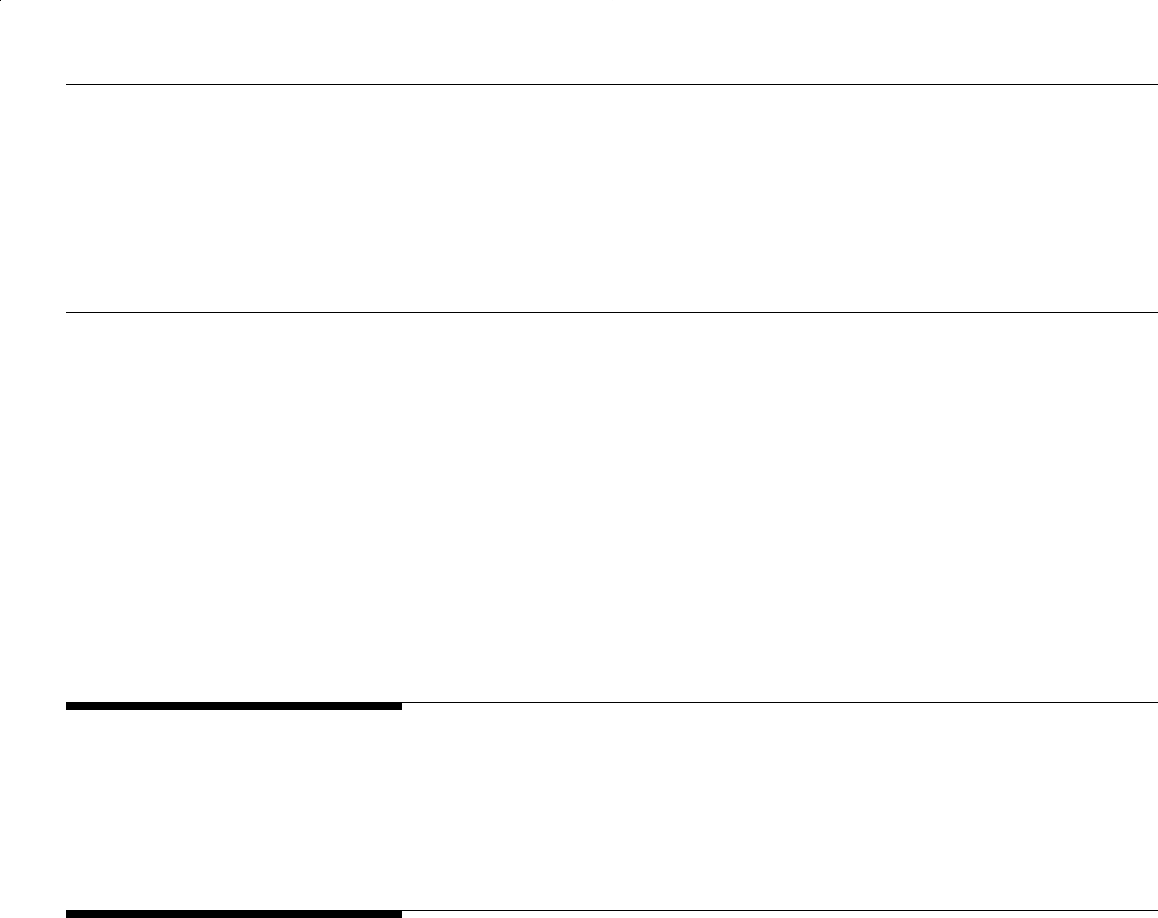
B-283016
Given the economic changes in the 60 years since the passage of the FLSA,
it is increasingly important to readjust these tests to meet the needs of the
modern work place. However, the different regulatory tests interact with
one another, and a change to one test can undermine or strengthen the
operation of other regulatory provisions. For example, elimination of the
salary-basis test could further weaken the protection offered to the
lower-income supervisor who is required to work a 60-hour work-week.
Raising the salary levels, on the other hand, adds more complexity to the
regulatory tests for executive employees by making the long duties test
applicable to at least some workers. Resolution of these concerns requires
a careful balancing of the needs of the employers for clear and
unambiguous regulatory standards with those of employees for fair and
equitable treatment in the work place.
Recommendation
We recommend that the Secretary of Labor comprehensively review the
regulations for the white-collar exemptions and make necessary changes
to better meet the needs of both employers and employees in the modern
work place. Some key areas of review are (1) the salary levels used to
trigger the regulatory tests, and (2) the categories of employees covered by
the exemptions.
Agency Comments
We provided a draft of this report to the Department of Labor for its
review and comments. In its comments,
DOL stated that the report was well
balanced and accurate in presenting the issues addressed. With respect to
the report’s recommendation,
DOL noted that the white-collar exemption
regulations are on its agenda to be reviewed in the future. The Department
noted that any change in the current regulatory structure requires
balancing the diametrically opposed, conflicting interests of the many and
differing constituencies that would be affected, and that the views of
interested parties are intractably held on opposite sides of the various
issues under these regulations.
DOL added that, given the current
regulatory environment, the prospects that it could successfully
implement consensus changes as we recommended are greatly
diminished. In addition, the agency provided other technical comments,
which we incorporated in the report as appropriate. (See appendix III for a
copy of
DOL’s written comments.)
We are sending copies of this report to the Honorable Alexis M. Herman,
Secretary of Labor; the Honorable Bernard E. Anderson, Assistant
Secretary for Employment Standards; the Honorable Katherine G.
GAO/HEHS-99-164 FSLA and White-Collar ExemptionsPage 35

B-283016
Abraham, Commissioner of the Bureau of Labor Statistics; appropriate
congressional committees; and other interested parties.
Please call me or Larry Horinko at (202) 512-7001 if you or your staff have
any questions about this report. Other major contributors to this report are
listed in appendix IV.
Cynthia M. Fagnoni
Director, Education, Workforce, and
Income Security Issues
GAO/HEHS-99-164 FSLA and White-Collar ExemptionsPage 36

GAO/HEHS-99-164 FSLA and White-Collar ExemptionsPage 37

Contents
Letter
1
Appendix I
Scope and
Methodology
40
Estimating the Number and Demographics of Workers Covered
by the White-Collar Exemptions
40
Identification of Statutory and Regulatory Changes 43
Determination of the Major Concerns of Employers and
Employees
43
Appendix II
Statutory and
Regulatory History of
FLSA White-Collar
Exemptions
45
Appendix III
Comments From the
Department of Labor
50
Appendix IV
GAO Contacts and
Staff
Acknowledgments
54
Tables
Table 1: Summary of Current Regulatory Tests for Executive,
Administrative, and Professional FLSA Exemptions
7
Table 2: Estimates of Full-Time White-Collar Workers Exempt in
1983 and 1998
8
Table 3: Summary of Major Statutory and Regulatory Revisions to
the White-Collar Exemptions
16
Table II.1: Statutory History of FLSA Section 13 on White-Collar
Exemptions, 1938-1998
45
Table II.2: Regulatory History of 29 CFR Part 541, Defining FLSA
White-Collar Exemptions, 1938-1998
46
GAO/HEHS-99-164 FSLA and White-Collar ExemptionsPage 38

Contents
Figures
Figure 1: Percentage of Full-Time Wage and Salary Workers in
1983 and 1998 by Industry
9
Figure 2: Percentage of Full-Time White-Collar Workers Exempt
in 1983 and 1998 by Industry
10
Figure 3: Percentage of Full-Time White-Collar Exempt and
Nonexempt Workforce in 1983 and 1998 by Gender
11
Figure 4: Percentage of Full-Time Exempt and Nonexempt
White-Collar Workers Who Worked Overtime in 1983 and 1998
12
Figure 5: Percentage of Full-Time Exempt and Nonexempt
White-Collar Workers in 1998 by Weekly Income
13
Figure 6: Number of Full-Time Exempt and Nonexempt
White-Collar Workers in 1998 by Weekly Income
14
Figure 7: Actual and Inflation-Adjusted Highest Salary Test, or
Upset Test, for Weekly Income, 1949-1998
27
Abbreviations
BLS Bureau of Labor Statistics
CPS Current Population Survey
DOL Department of Labor
FLSA Fair Labor Standards Act
GAO/HEHS-99-164 FSLA and White-Collar ExemptionsPage 39
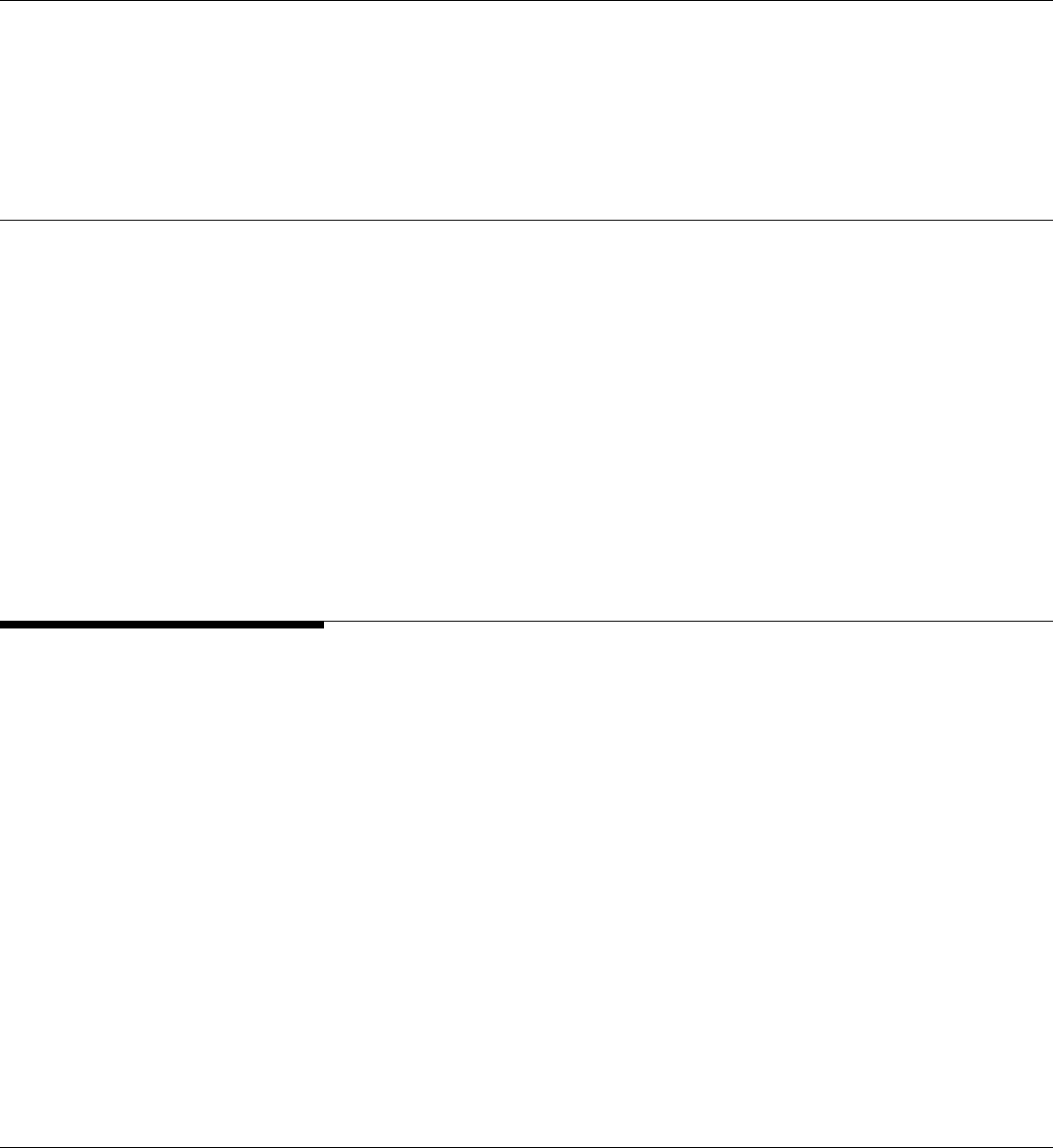
Appendix I
Scope and Methodology
We used a variety of data sources to develop and provide updated
information on the white-collar exemptions. To estimate the number and
demographic characteristics of the portion of the American workforce
who were executive, administrative, and professional employees covered
by the white-collar exemptions in 1998 and 1983, we used the Bureau of
the Census’ Current Population Survey (
CPS) Outgoing Rotations data. To
identify statutory and regulatory changes since 1938, we reviewed various
legal reports and publications. To determine the major concerns of
employers and employees regarding the white-collar exemptions, we
reviewed 166 federal court cases on this subject and 66 Department of
Labor (
DOL) compliance cases, and held discussions with employers,
unions,
DOL officials, and various legal and economic experts. We
performed our work between November 1998 and June 1999 in
accordance with generally accepted government auditing standards.
Estimating the
Number and
Demographics of
Workers Covered by
the White-Collar
Exemptions
To estimate the number and demographic characteristics of exempt
white-collar workers, we did not attempt to count the number of
employees actually classified as exempt by employers but, rather, to
determine how many employees were covered by the regulatory tests for
the white-collar exemptions in 1983 and 1998. We reviewed several Bureau
of Labor Statistics (
BLS) and DOL reports to determine whether any data
sources could be used for our purposes. After discussions with
DOL and
experts, we decided that the
CPS Outgoing Rotations was the best available
data source to estimate both the proportion of the labor force that is
covered by the white-collar exemptions and the demographic
characteristics of this population. The
CPS is conducted by the Bureau of
the Census for the
BLS. The Outgoing Rotations data are collected as part
of the basic
CPS labor-force interview and provide data on weekly earnings
along with the demographic information such as age, gender, and race.
The
CPS is a survey of households collected each month from a probability
sample of approximately 50,000 households. The
CPS provides
self-reported information on the labor-force status of the civilian
noninstitutional population 16 years of age and over. Our analysis covered
calendar years 1998 and 1983.
General Methodology
To estimate the number of workers covered by the white-collar
exemptions using the
CPS data, our primary focus was on two questions:
(1) Was the worker paid a salary? (2) What was the worker’s primary job
classification? The
CPS data include 905 occupational classifications.
Respondents are asked to describe the kind of work they are doing, and
GAO/HEHS-99-164 FSLA and White-Collar ExemptionsPage 40

Appendix I
Scope and Methodology
CPS coders classify these duties into one of the 905 job titles. To determine
which of the 905 job titles would likely include exempt white-collar
workers, we asked the
DOL officials to assess the likelihood of exemption
for each occupation.
DOL officials responded by classifying each of the 905
occupations individually by its likelihood of exemption. Overall,
DOL
officials determined that 257 of the 905 job titles would likely include
exempt workers. For each of these 257 job titles,
DOL officials provided us
with one of four ranges of likelihood that workers would be covered by
the white-collar exemptions: 90-100 percent, 50-90 percent, 10-50 percent,
and 0-10 percent.
29
To develop our estimate, we analyzed each of the 257 job titles likely to
include exempt workers. In determining which of the workers in the
sample would likely be exempt and therefore included in our estimate, we
applied the percentage ranges provided by the officials at
DOL. To better
refine the application of these percentage ranges (which were estimates of
the likelihood that the positions would include managerial or professional
duties), we made the following assumption: duties that make an employee
more likely to be covered by the white-collar exemptions are duties that,
generally speaking, elicit a higher salary. Under this assumption, as
workers have more exempt duties and responsibilities, their incomes
increase—as does the likelihood of being exempt. Therefore, we applied
the percentage ranges provided by
DOL officials to give increasing weight
to workers with higher incomes. All workers, except physicians, lawyers,
and teachers, earning less than $250 per week were considered nonexempt
and were eliminated from our calculation of the exempt population. The
exemption for physicians, lawyers, and teachers does not depend on the
income of the employee.
Using this method for each of the 257 occupations, we generated our
estimates for the low and high estimates of the potentially exempt
population for both 1983 and 1998. After we estimated the population
covered by the white-collar exemptions, we determined its demographic
characteristics. Our analysis included information on gender, industry,
weekly earnings, and overtime hours worked.
Our work presents data for six industry groupings: (1) services; (2) retail
trade; (3) manufacturing; (4) finance, insurance, and real estate; (5) public
sector; and (6) other. We developed these groups by combining 932
detailed
CPS industry codes. The service sector includes four types of
service occupations: business and repair, entertainment and recreation,
29
These ranges were not overlapping since each occupation is assigned a different range.
GAO/HEHS-99-164 FSLA and White-Collar ExemptionsPage 41

Appendix I
Scope and Methodology
professional and related services, and personal services. Retail trade
includes all types of retail stores. Manufacturing includes durable and
nondurable goods. The finance, insurance, and real estate category
includes banking, credit agencies, security companies, and insurance and
real estate offices. Public sector includes federal, state, and local
government workers. The final category, other industries, includes
agriculture, forestry, fishery, mining, construction, wholesale trade,
transportation, communications, public utilities, and public
administration.
Data Limitations Related to
the Use of the CPS
There are two major limitations on the use of CPS data. First, the CPS
occupational classifications do not distinguish between supervisory and
nonsupervisory employees, which is important for the long and short
duties tests under the Fair Labor Standards Act (
FLSA). Therefore, one job
title, “managers and administrators,” could include the President of
General Motors, but it may also include an office assistant. Second,
CPS
respondents self-identify their duties and some may tend to exaggerate
them. This may result in overestimates of the number of management
employees and, consequently, may overestimate the number of exempt
employees.
We corrected for these data limitations by giving increasing weight to
workers with higher incomes and by applying the percentage ranges
provided by
DOL officials.
Sources of Uncertainty
There are two sources of uncertainty in our estimation of the potentially
exempt population.
The first source of uncertainty is methodological and related to the
probability of exemption for each occupation.
DOL officials provided us
with one of four ranges of likelihood of exemption for each occupation.
Our low estimate is based on the lowest likelihood of exemption in each of
the four ranges and our high estimate is based on the highest likelihood in
each range.
The second source of uncertainty is sampling error, due to our use of the
CPS survey of households. Rather than counting the number of employees
actually classified as exempt by employers, we estimated how many
employees are likely to be classified as exempt, based on the occupational
classifications and income reported in the
CPS sample.
GAO/HEHS-99-164 FSLA and White-Collar ExemptionsPage 42

Appendix I
Scope and Methodology
The high and low estimates we report reflect the methodological
uncertainty, which is much larger than the sampling error. For example,
consider table 2. The table shows that the high estimate of workers
covered by the white-collar exemptions in 1983 is 17 million. For the same
year, our low estimate is 12 million workers. The difference between the
high and low estimate—5 million workers—is the amount of uncertainty
due to methodological process we describe as our first source of
uncertainty. On the other hand, the sampling error—the second source of
uncertainty—involves an estimated error of plus or minus 700,000 people.
Identification of
Statutory and
Regulatory Changes
We reviewed legislative references to identify changes to the FLSA. For the
regulatory changes, we reviewed annual publications of the Code of
Federal Regulations for the period 1959 to the present; for the period 1938
to 1959, we relied on three
DOL hearing reports provided to us by DOL.
Determination of the
Major Concerns of
Employers and
Employees
To obtain information on the major concerns of employers and employees
about the white-collar exemptions, we used four sources: (1) review of
federal court decisions involving white-collar exemption issues over the
5-year period from January 1994 through December 1998; (2) review of
DOL
compliance cases related to white-collar exemptions that were closed in
the 2-year period between January 1997 through December 1998 in four
DOL field offices; (3) interviews with individuals and groups representing
the interests of employers; and (4) interviews with individuals and groups
with knowledge about the interests of employees. In the paragraphs
below, we present more detail on each of these sources.
Review of Federal Court
Cases
We reviewed 166 judicial opinions from federal appellate and district
courts involving litigation related to the white-collar exemptions during
the 5-year period from 1994 through 1998. To identify these cases, we
conducted a computer search of federal opinions in this period.
30
We
categorized each of the 166 cases as being related to one of four issues: the
salary-basis test, the executive classification, the administrative
classification, or the professional classification. For cases involving more
than one white-collar exemption issue, we selected one issue to be the
primary issue. In addition to the primary issue, we also collected data on
other circumstances of each case, such as who prevailed on the issue and
whether the case involved multiple employees suing their employer.
30
To avoid double counting, we eliminated district court cases that were later heard by an appellate
court, and we only used the appellate decision in our sample.
GAO/HEHS-99-164 FSLA and White-Collar ExemptionsPage 43

Appendix I
Scope and Methodology
Review of DOL
Compliance Cases
We supplemented our review of federal court decisions with a review of 66
DOL compliance cases from 4 of its 57 District Offices. At our request, the
four District Offices—in the Northeast (Boston), South (Richmond),
Midwest (Chicago), and West (Los Angeles)—identified compliance cases
closed in the 2-year period between January 1997 and December 1998 that
involved white-collar issues. Each office identified cases that we reviewed
and discussed with district managers and investigators who were familiar
with the cases. As with the federal court decisions, we categorized each of
the cases as being related to one of four issues: the salary-basis test, the
executive classification, the administrative classification, or the
professional classification.
Employer Perspectives
To identify the key concerns of employers related to the white-collar
exemptions, we met with private and public employers, trade associations,
DOL officials, and various legal and economics experts. The Society for
Human Resource Management, a group of human resource managers from
companies with over 100 employees, organized two group sessions—one
with banking and insurance human resource managers, and the other with
manufacturing human resource managers. We also met with the Labor
Policy Association—a group representing companies with business
operations in the United States and with more than 2,500 employees each.
In addition to these company managers, we met with attorneys and
associations representing manufacturing companies, retail companies, and
small businesses. On the public employment side, we met with
representatives from various cities and public employer groups, as well as
separately with four legal experts representing public employers across
the country. Finally, we met with
DOL officials in the Wage and Hour
Division and the Office of the Solicitor.
Employee Perspectives
To identify the concerns of employees, we met with union representatives
and officials,
DOL officials, and legal and economic experts. We met with
the American Federation of Labor-Congress of Industrial Organizations
and officials from nine different unions and trade union representatives.
We also interviewed several legal and economic experts who specialize in
issues relating to the
FLSA and, in particular, white-collar exemptions.
GAO/HEHS-99-164 FSLA and White-Collar ExemptionsPage 44

Appendix II
Statutory and Regulatory History of FLSA
White-Collar Exemptions
The Fair Labor Standards Act at sec. 13(a)(1) established the so-called
white-collar exemptions: any employee in a “bona fide executive,
administrative, or professional capacity” is exempted from the minimum
wage and overtime requirements of the
FLSA. After the original enactment
of the
FLSA in 1938, the Department promulgated regulations (at 24 C.F.R.
part 541) defining the terms included in section 13(a)(1). Since 1938, there
have been changes to both the statute and the regulations. In the following
tables, we outline these changes.
Table II.1: Statutory History of FLSA Section 13(a)(1) on White-Collar Exemptions, 1938-1998
Year Legislation Summary of change
1938 Fair Labor
Standards Act of
1938 (P.L. 75-718)
As originally enacted in 1938, sec. 13(a)(1) provided that the minimum wage (section 6) and overtime
provisions (section 7) of the FLSA did not apply to “any employee employed in a bona fide executive,
administrative, professional, or local retailing capacity.”
1961 Fair Labor
Standards
Amendments of
1961 (P.L. 87-30)
This amendment limited the exemption for retail employees. It eliminated the separate exemption
category for workers employed in a “local retailing capacity.” This separate exemption was replaced
with a proviso that an employee of a retail or service establishment could not be excluded from the
definition of executive or administrative capacity because of the amount of time devoted to other than
executive or administrative activities if less than 40 percent of his or her work hours included such
activities.
1966 Fair Labor
Standards
Amendments of
1966 (P.L. 89-601)
In 1966, public educational institutions were made subject to the requirements of the FLSA. However,
this amendment exempted academic administrative personnel and teachers in elementary and
secondary schools from these requirements by expressly including them under sec. 13(a)(1).
1972 Education
Amendments of
1972 (P.L. 92-318)
This amendment made the equal-pay provision of the FLSA at sec. 6(d) applicable to employees who
were otherwise exempt from the FLSA under sec. 13(a)(1).
1996 Small Business
Job Protection Act
of 1996 (P.L.
104-188)
This amendment, enacted into law at sec. 13(a)(17) of the FLSA, contians the description of computer
professionals who are exempt employees. By its terms, employees who meet the duties test of the
exemption are exempt from the FLSA as long as they earn not less than $27.63 per hour.
Source: GAO analysis of applicable laws and legislative history.
GAO/HEHS-99-164 FSLA and White-Collar ExemptionsPage 45

Appendix II
Statutory and Regulatory History of FLSA
White-Collar Exemptions
Table II.2: Regulatory History of 29 CFR Part 541, Defining FLSA White-Collar Exemptions, 1938-1998
Year
Federal Register notice
of regulation change
Part 541 subsections
affected Summary of change
1938 3 Fed. Reg. 2518,
Oct. 20, 1938
Regulation included
subsec. 1-5
The Fair Labor Standards Act of 1938 in sec. 13(a)(1) exempted “any
employee employed in a bona fide executive, administrative,
professional or local retailing capacity” from the requirements of the
Act. To define these terms, part 541 was added to the Department
regulations in 29 C.F.R. chapter V. The new regulations defined these
exempt employees, as follows:
—The new regulation combined executive and administrative at sec.
541.1 to include any employee whose primary duty is the “management
of the establishment, or a customarily recognized department thereof”
and who “customarily and regularly directs the work of other employees
therein.” It also set a salary level—to be exempted, an employee had to
be compensated at not less than $30 per week.
—Separate definitions were included for professional employees (sec.
541.2: “customarily and regularly engaged in work predominantly
intellectual and varied in character as opposed to routine mental,
manual, mechanical or physical work”) and retail employees (sec.
541.3: “customarily and regularly engaged in making retail sales”).
There was no salary limit for either professional or retail employees.
1940 5 Fed. Reg. 4077,
Oct. 15, 1940
Regulation revised
subsec. 1-5, adding new
sec. 2
In accommodating the views of interested employers, employees, trade
associations, and unions, the Department revised the definitions of
executive, administrative, and professional to include separate duties
and salary tests for each type of exempt employee. These revisions
included the following:
—For executive employees, the revised regulations at sec. 541.1
retained much of the original language, but specified that the employee
could not spend more than 20 percent of the work-week on “work of the
same nature as performed by nonexempt employees” unless in “sole
charge” of an independent establishment. The executive was to be
paid on a salary basis at least $30 per week.
—Administrative employees were newly defined in sec. 541.2 as those
employees who performed nonmanual work that required the exercise
of discretion and independent judgment. The administrative employee
was to be paid on a salary or fee basis at least $200 per month.
—For professional employees, the regulations in sec. 541.3 added a
new requirement that they either had knowledge of an advanced type
in a field of science or learning or performed work predominantly
original and creative in character. They also had to be paid on a salary
or fee basis at least $200 month unless they were licensed doctors or
lawyers.
1942 7 Fed. Reg. 332,
Jan. 17, 1942
Revised subsec. 2 This revision added para. (b)(4) to the definition of administrative
employees, specifically exempting employees engaged in transporting
goods or passengers for hire. According to a 1949 DOL report, this
provision was intended to exempt employees engaged in ferrying
airplanes. (This provision was eliminated in 1949.)
(continued)
GAO/HEHS-99-164 FSLA and White-Collar ExemptionsPage 46

Appendix II
Statutory and Regulatory History of FLSA
White-Collar Exemptions
Year
Federal Register notice
of regulation change
Part 541 subsections
affected Summary of change
1949 14 Fed. Reg. 7705,
Dec. 24, 1949
Revised subsec. 1-6 After 10 years of administrative experience, the Department once again
revised the regulations. For the most part, these changes resulted from
recommendations from the DOL’s regional directors and field staff.
Among other things, the changes included the following:
—A special “upset” test was added to the tests determining
administrative, executive, or professional employees: if the employee
made at least $100 per week (a “high-salaried” employee), then he or
she only had to meet a “short-cut” version of the original long duties
test.
—The basic salary test was increased: executives had to make at least
$55 per week; administrators, at least $75 per week; and professionals,
at least $75 per week.
—For executives, the regulations specified that they must supervise
two or more employees.
1949 14 Fed. Reg. 7730,
Dec. 28, 1949
Added new Subpart
B—Interpretations
To respond to requests from its field staff for explanatory material on
the 541 regulations, the DOL published an explanatory bulletin. This
bulletin, added to the regulation as Subpart B, contained statements of
general policy directly related to the 541 regulations. Among other
things, the bulletin:
—Elaborated upon the terms included in subsec. 1-6; such terms
included primary duty (541.103), sole charge (541.113) and salary
basis (541.118).
—Added new terms to the regulations, such as working foremen
(541.115) and combination exemptions (541.600).
—Applied the regulations to specific professions, such as newspaper
reporters (541.303f) and radio announcers (541.303e).
1953 18 Fed. Reg. 3930,
July 7, 1953;
error in original notice
corrected by 18 Fed.
Reg. 4098, July 14, 1953
Added subsec. 5(a) and
601
Subsec. 5a made the requirement that exempt employees be paid on a
salary basis not applicable to employees in the
motion-picture-producing industry who were compensated at certain
minimum rate, and subsec. 601 explained how to apply this provision.
1954 19 Fed. Reg. 4405,
July 17, 1954
Revised subsec. 118 Subsec. 118, which explains the salary-basis test, was revised, in
principal part, as follows:
—Subsec. 118(a) specified that an employee must receive a full salary
“without regard to the number of days or hours worked.” This revision
explained the application of this rule to different pay deductions; for
example, an employer cannot deduct pay for a lack of work
(541.118(a)(1)) or for personal absences of less than 1 day
(541.118(a)(2)) or for jury duty (541.118(a)(4)).
—In addition, a new subsec. 118(a)(6) allowed an employer, under
certain circumstances, to correct improper pay deductions if the
employer reimbursed the employee and promised to comply in the
future (the so-called window of correction).
1958 23 Fed. Reg. 8962, Nov.
18, 1958
Revised subsec. 1, 2,
and 3
This revision increased the salary tests for exempt employees:
—Executive employees had to be paid at least $80 per week;
administrative employees, at least $95 per week; and professional
employees, at least $95 per week.
—The so-called “upset test” for high-salaried employees was also
increased to $125 per week for all three types of exempt workers.
(continued)
GAO/HEHS-99-164 FSLA and White-Collar ExemptionsPage 47

Appendix II
Statutory and Regulatory History of FLSA
White-Collar Exemptions
Year
Federal Register notice
of regulation change
Part 541 subsections
affected Summary of change
1959 24 Fed. Reg. 581,
Jan. 27, 1959
Revised subsec. 100,
117, 118, 119, 200, 211,
300, 311, 313, 315, 600
This revision adjusted the provisions in Subpart B—Interpretations to
match the salary test increases published in November 1958.
1961 26 Fed. Reg. 8635,
Sept. 15, 1961
Revised subsec. 1, 2, 3,
99, 100, 101, 105, 109,
112, 113, 114, 200, 209,
300, 308; revoked
subsec. 4, 400, 401,
402, 403
This revision implemented the Fair Labor Standards Amendments of
1961, which eliminated the exemption for employees in a “local retailing
capacity.” The amendments replaced it with a proviso that retail
employees could not be excluded from the executive or administrative
exemptions because of the amount of time they spent performing
activities that are not managerial or administrative if less than 40
percent of the employee’s time was devoted to such activities.
1963 28 Fed. Reg. 9505, Aug.
30, 1963, typographical
error in original notice
corrected by 28 Fed.
Reg. 14423, Dec. 28,
1963
Revised subsec.
included 1, 2, 3, 100,
105, 108, 109, 112, 113,
117, 118, 119, 200, 201,
202, 205, 207, 209, 211,
300, 311, 315, 600;
added subsec. 5b
This revision updated Subpart B—Interpretations to include illustrative
examples relating to retail work. It also increased the salary test for
exempt employees:
—Executive employees had to be paid a salary of at least $100 per
week; administrative employees, at least $100 per week; and
professional employees, at least $115 per week.
—The upset test triggering the short duties test was increased to $150
per week for all three types of exempt employees.
—The increased salary test was not effective for retail employees until
September 3, 1965.
1967 32 Fed. Reg. 7823,
May 30, 1967
Revised subsec.
included 1, 2, 3, 112,
200, 201, 202, 300, 302,
304, 307, 314, 315, 602
This revision was made to implement the changes in the law made by
the Fair Labor Standards Amendments of 1966, which made public
educational institutions subject to the FLSA for the first time. It also
amended the Act to specifically include academic administrative
personnel and teachers in elementary and secondary schools in sec.
13(a)(1). The regulatory changes pursuant to this amendment included,
among other things:
—Subsec. 2 was expanded to specify an administrative exemption for
performance of administrative functions in a school system.
—Subsec. 3 included a professional exemption for teachers in a school
system or educational establishment.
—Teachers, as well as doctors and lawyers, were excepted from the
requirement for a minimum salary level.
1970 35 Fed. Reg. 883,
Jan. 22, 1970
(35 Fed. Reg. 3220,
Feb. 20, 1970, extended
the effective date of the
salary increase)
Revised subsec. 1, 2, 3,
5b, 100, 117, 118, 119,
200, 211, 214, 300, 311,
313, 315, 600; revoked
subsec. 200 and 300
These revisions increased the salary test for exempt employees:
—Executive employees had to be paid at least $125 per week;
administrative employees, at least $125 per week; and professional
employees, at least $140 per week.
—The upset test triggering the short duties test was increased for all
three types of employees to $200 per week.
1971 36 Fed. Reg. 22976,
Dec. 2, 1971
Revised subsec.
included 103, 207, 302
These revisions to Subpart B included additional explanatory
guidelines for paramedical and data-processing employees, as well as
for the professional exemption.
1973 38 Fed. Reg. 11390,
May 7, 1973
Revised subsec.
included 1, 2, 3, 52, 117,
118, 119, 214, 311, 313,
315, 601
These revisions reflect the changes made in the law by the Education
Amendments of 1972, which made the equal-pay provision of the FLSA
applicable to otherwise-exempt employees.
(continued)
GAO/HEHS-99-164 FSLA and White-Collar ExemptionsPage 48

Appendix II
Statutory and Regulatory History of FLSA
White-Collar Exemptions
Year
Federal Register notice
of regulation change
Part 541 subsections
affected Summary of change
1975 40 Fed. Reg. 7092,
Feb. 19, 1975
Revised subsec. 1, 2, 3,
117, 118, 119, 211, 214,
311, 313, 315, 601
These revisions increased the salary test for exempt employees:
—Executive employees had to be paid at least $155 per week;
administrative employees, at least $155 per week; and professional
employees, at least $170 per week.
—The upset test triggering the short duties test was increased for all
three types of employment to $250 per week.
1981 46 Fed. Reg. 3010,
Jan. 13, 1981
(postponed indefinitely);
46 Fed. Reg. 11972,
Feb. 12, 1981; and 46
Fed. Reg. 11972, Feb.
12, 1981
Revised subsec. 1, 2, 3,
117, 118, 119, 211, 214,
311, 313, 315, 601;
revoked subsec. 52
These revisions, which were indefinitely postponed by Presidential
memorandum of Jan. 29, 1981, would have increased the salary test
for exempt employees:
—Executive employees would have had to be paid at least $225 per
week; administrative employees, at least $225 per week; and
professional employees, at least $250 per week. In 2 years, these base
salaries would have been raised to $250 per week for executive and
administrative employees, and to $280 per week for professional
employees.
—The upset test triggering the short duties test would have increased
for all three types of employment to $320 per week. In 2 years, this test
would have been raised to $345 per week.
1991,
1992
56 Fed. Reg. 45824,
Sept. 6, 1991, as revised
and finalized at 57 Fed.
Reg. 37666,
Aug. 19, 1992
Added subsec. 5d This new subsection was added in response to conflicting court
decisions and the accompanying confusion, and the need to treat
public employees differently than private employees because of the
requirement for public accountability. It made the requirement of
payment on a salary basis generally, but not completely, inapplicable
to exempt state and local employees.
1992 56 Fed. Reg. 8250, Feb.
27, 1991, as finalized at
57 Fed. Reg. 46742, Oct.
9, 1992 (corrected by 57
Fed. Reg. 47163,
Oct. 14, 1992)
Revised subsec. 3, 5c,
302, 312; added subsec.
303
This revision implemented sec. 2 of P.L. 101-583 which directed the
Secretary of Labor to promulgate regulations that permitted computer
systems analysts, computer programmers, software engineers, and
other similarly skilled workers to be classified as exempt employees. As
specified by the law, these revisions exempted workers whose duties
met the new test set forth in the regulation and, if they were paid on a
salary basis, their pay met the specified salary test levels; or, if they
were paid on an hourly basis, their regular rate of pay exceeded 6-1/2
times the minimum wage.
a
Source: GAO analysis of applicable regulations.
a
P.L. 104-188 subsequently set the hourly wage that would allow employers to claim an
exemption for computer workers at $27.63 per hour, but no corresponding change was made in
the regulations.
GAO/HEHS-99-164 FSLA and White-Collar ExemptionsPage 49
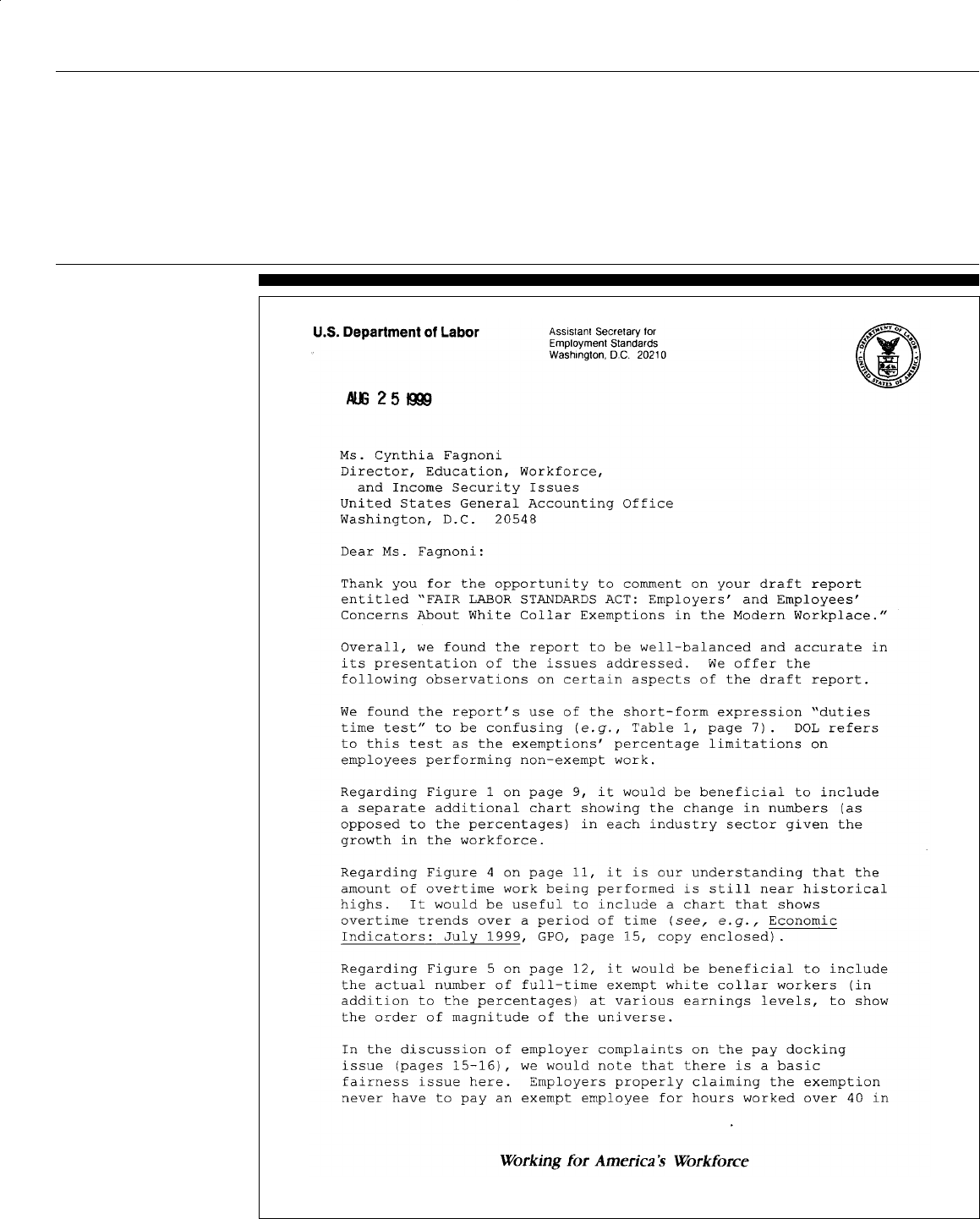
Appendix III
Comments From the Department of Labor
Now on p. 7.
Now on p. 9.
Now on p. 12.
Now on p. 13.
Now on pp. 17-19.
GAO/HEHS-99-164 FSLA and White-Collar ExemptionsPage 50
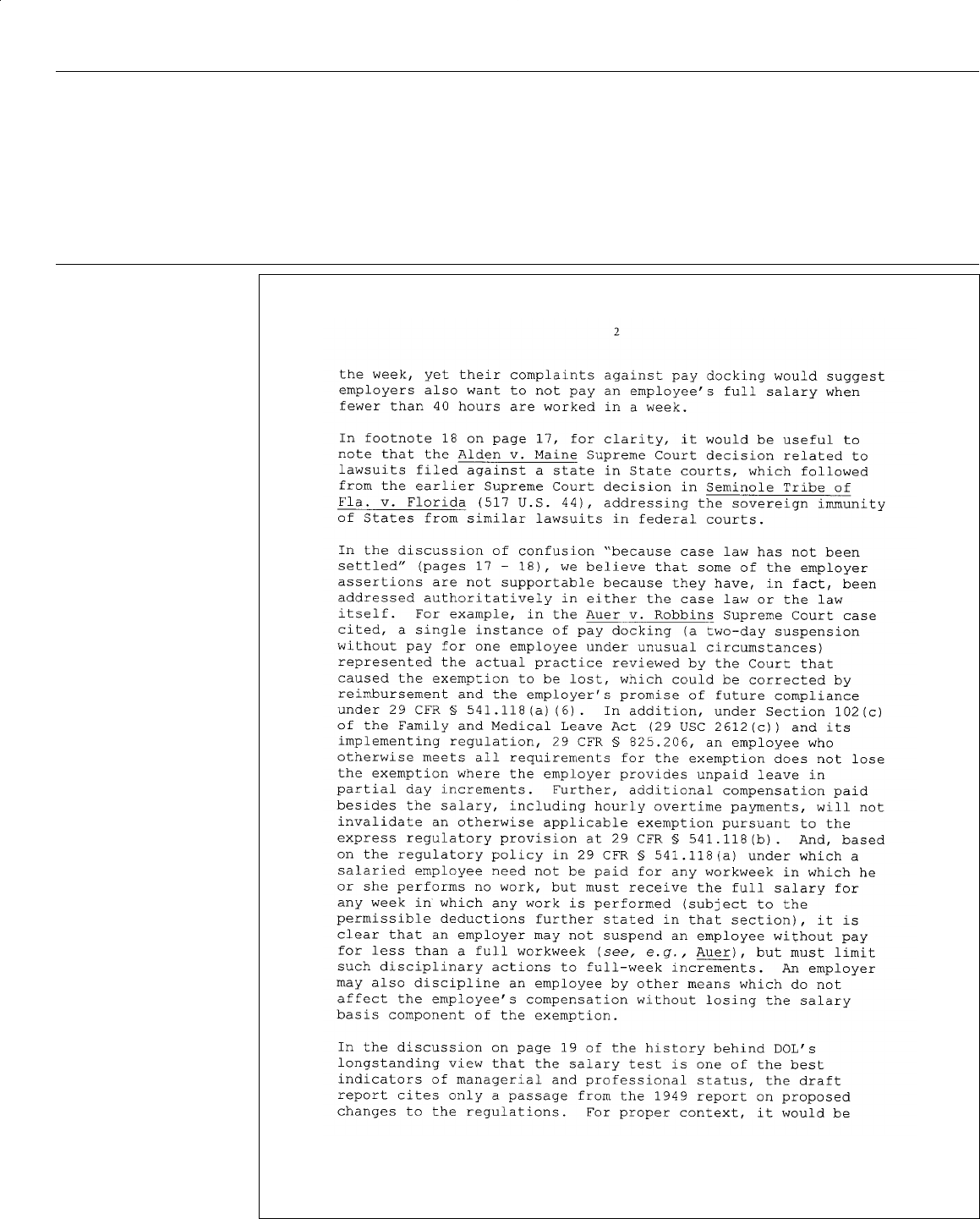
Appendix III
Comments From the Department of Labor
Now on p. 18.
Now on p. 19.
Now on p. 20.
GAO/HEHS-99-164 FSLA and White-Collar ExemptionsPage 51
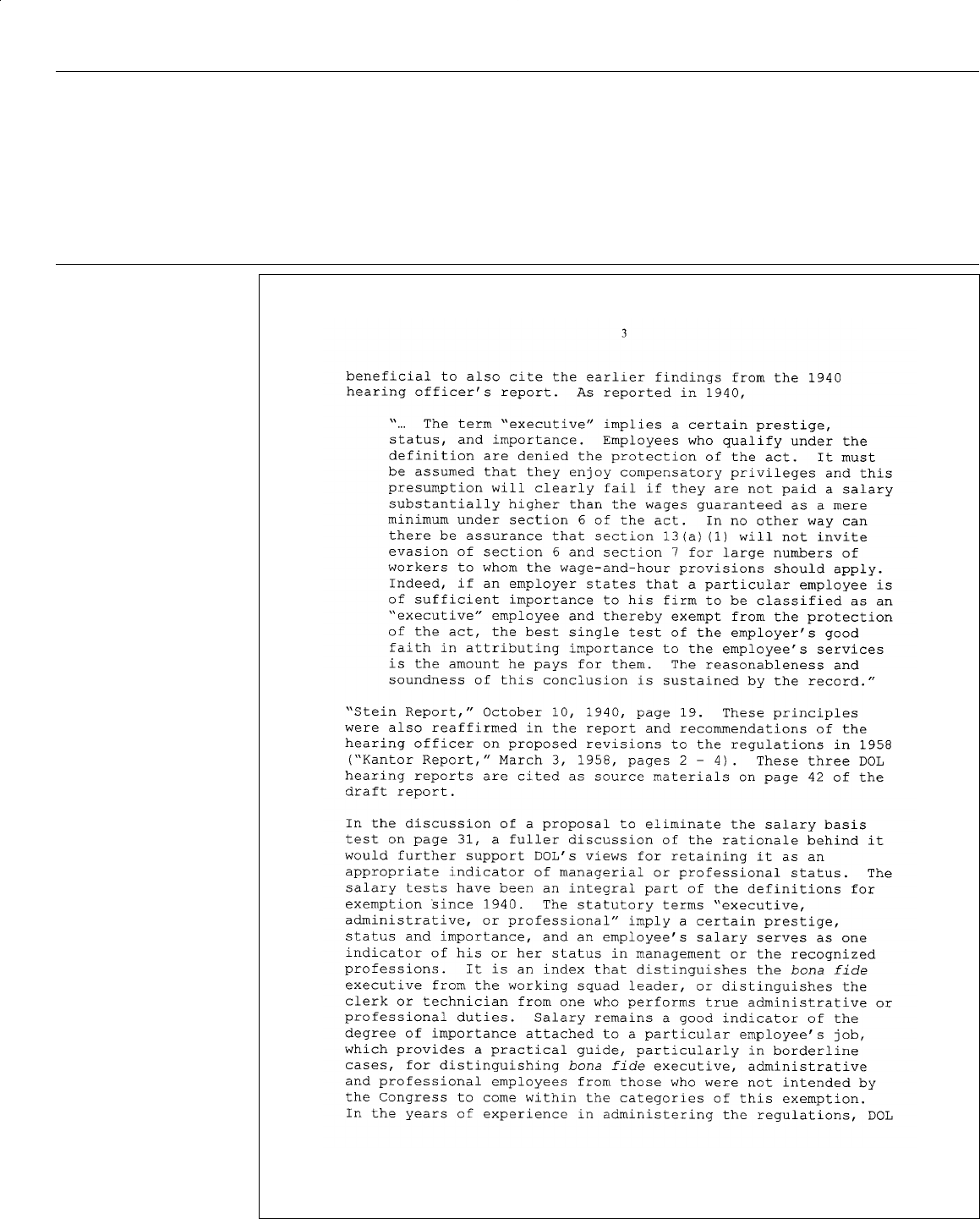
Appendix III
Comments From the Department of Labor
Now on p. 20.
Now on p. 31.
GAO/HEHS-99-164 FSLA and White-Collar ExemptionsPage 52
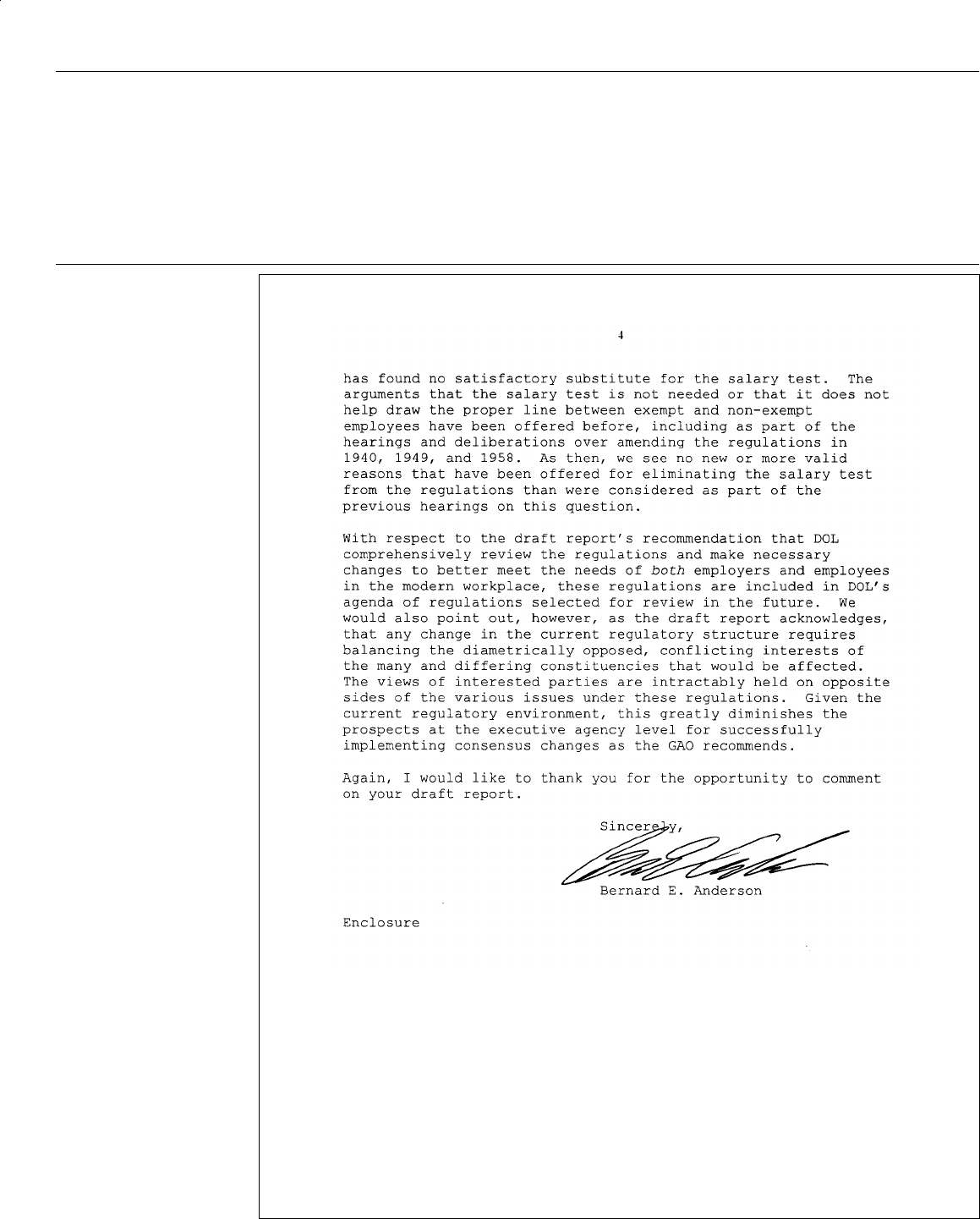
Appendix III
Comments From the Department of Labor
GAO/HEHS-99-164 FSLA and White-Collar ExemptionsPage 53

Appendix IV
GAO Contacts and Staff Acknowledgments
GAO Contacts
Larry Horinko, (202) 512-7001
Nancy Peters, (202) 512-9065
Staff
Acknowledgments
In addition to those mentioned above, Carol Patey, Bill Hansbury, Rich
Kelley, Kelly Mikelson, Charlie Jeszeck, and Robert Crystal made key
contributions to this report.
(205387) GAO/HEHS-99-164 FSLA and White-Collar ExemptionsPage 54

Ordering Information
The first copy of each GAO report and testimony is free.
Additional copies are $2 each. Orders should be sent to the
following address, accompanied by a check or money order
made out to the Superintendent of Documents, when
necessary. VISA and MasterCard credit cards are accepted, also.
Orders for 100 or more copies to be mailed to a single address
are discounted 25 percent.
Orders by mail:
U.S. General Accounting Office
P.O. Box 37050
Washington, DC 20013
or visit:
Room 1100
700 4th St. NW (corner of 4th and G Sts. NW)
U.S. General Accounting Office
Washington, DC
Orders may also be placed by calling (202) 512-6000
or by using fax number (202) 512-6061, or TDD (202) 512-2537.
Each day, GAO issues a list of newly available reports and
testimony. To receive facsimile copies of the daily list or any
list from the past 30 days, please call (202) 512-6000 using a
touchtone phone. A recorded menu will provide information on
how to obtain these lists.
For information on how to access GAO reports on the INTERNET,
send an e-mail message with "info" in the body to:
or visit GAO’s World Wide Web Home Page at:
http://www.gao.gov
PRINTED ON RECYCLED PAPER

United States
General Accounting Office
Washington, D.C. 20548-0001
Official Business
Penalty for Private Use $300
Address Correction Requested
Bulk Rate
Postage & Fees Paid
GAO
Permit No. G100
